
Brigitte Bardot and Marcello Mastroianni in Vie privée (1962)
Czechoslovakian postcard by Pressfoto, Praha, 1964, no. C 36. Brigitte Bardot and Marcello Mastroianni in Vie privée / Private Life (Louis Malle, 1962).Film actor Marcello Mastroianni (1924-1996) was Italy's favourite leading man since the 1950s, as well as one of the finest actors of European cinema. In his long and prolific career, Mastroianni almost singlehandedly defined the contemporary type of Latin lover, then proceeded to redefine it a dozen times and finally parodied it and played it against type.Beautiful French actress Brigitte Bardot (1934) was the sex kitten of the European film industry. BB starred in 48 films, performed in numerous musical shows, and recorded 80 songs. After her retirement in 1973, she established herself as an animal rights activist and made vegetarianism sexy.And please check out our blog European Film Star Postcards.

Henry Salvador
French postcard by Editions P.I. Photo: * Star, Paris.French Caribbean comedian, singer and cabaret artist Henri Salvador (1917-2008) was the first to sing Rock and Roll songs in France and was honoured for helping create the Bossa Nova. He appeared in several films but peaked in the 1960s when he had his own TV shows.Henri Gabriel Salvador was born in 1917 in Cayenne, French Guyana. His father, Clovis, and his mother, Antonine Paterne, daughter of an Indigenous Carib, were both from Guadeloupe, French West Indies. Salvador had a brother, André, and a sister, Alice. At 12, Henri (sometimes written as Henry) and his family moved to France. Salvador performed as a musician and comedian in Parisian cabarets from 1933. He learned to play guitar by imitating Django Reinhardt's recordings and collaborated with him in the 1930s. He began his musical career as a guitarist accompanying other singers. After years of cabarets, little jobs and military service, he got a real chance to aim for fame when he got hired by orchestra leader Ray Ventura. When Ray Ventura and his band went to play in Brazil during World War II, Henri Salvador became popular over there as a singer and funnyman. Back in France after the war ended, Henri Salvador left Ray Ventura behind and started his own career. His first record, which included 'Clopin-Clopant' and 'Maladie d'Amour' (covered by the Ames Brothers as "Mélodie d'Amour") became an instant hit. Salvador recorded several songs written by Boris Vian with Quincy Jones as arranger. Henri Salvador made his film debut in Le moulin des Andes (Jacques Rémy, 1945) with Nora Gregor. In the following years, he appeared with Ray Ventura in the comedies Mademoiselle s'amuse / Mademoiselle Has Fun (Jean Boyer, 1948), Nous irons à Paris / We Will All Go to Paris (Jean Boyer, 1949) with the Peters Sisters and Nous irons à Monte-Carlo (Jean Boyer, 1950) with the young Audrey Hepburn. His later films include the musical comedy Bonjour sourire! / Hello Smile! (Claude Sautet, 1956) with Jimmy Gaillard and Un clair de lune à Maubeuge / Moonlight in Maubeuge (Jean Chérasse, 1962) with Claude Brasseur.Henri Salvador is known to have recorded the first French rock and roll songs in 1957 written by Boris Vian and Michel Legrand — 'Rock'n Roll Mops', 'Rock hoquet, Va t'faire cuire un oeuf, man' and 'Dis-moi qu'tu m'aimes rock' — under the artist name of Henry Cording (a play on the word Recording). Despite this historical aspect, he never ceased claiming that he disliked rock and roll and even refused to talk about this subject later. Henri Salvador influenced Antônio Carlos Jobim in formulating the Brazilian Bossa Nova style. In 1957, Salvador composed the song ‘Dans mon île' and performed it on guitar, in the form of a samba with a very slow tempo and rich harmonies. He played this song in the Italian film Europa di notte, which was screened in Brazil in the spring of 1959 and seen by several musicians who warned Antônio Carlos Jobim. The song went on to become popular in Brazil. In 2023, the documentary film ‘Face B comme bossa, l'autre histoire d'Henri Salvador’ confirmed that this song was indeed one of the influences of this musical style in the late 1950s. In the 1960s, Salvador was the host of several popular television variety shows on French TV. In 1964, he scored a hit with 'Zorro est arrivé', which was adapted from The Coasters' U.S. hit 'Along Came Jones'. He is also famous for his rich, catchy laugh, which is a theme in many of his humorous songs. In 1969, Henri Salvador recorded a variation of 'Mah Nà Mah Nà' entitled 'Mais non, mais non' with lyrics he had written in French to Piero Umiliani's music. Salvador had many hits, including humorous songs ('Faut rigoler', 'Je peux pas travailler', 'Blouse du dentiste') and sweet ballads ('Le loup, la biche et le chevalier', 'Syracuse', 'Jardin d'hiver'). At the age of 70, Salvador was the voice-over of the crab Sebastian in the French dubbing of Disney's The Little Mermaid (1989) and sang the song 'Embrasse-la' ('Kiss the Girl'). After a period of relative obscurity towards the end of his life, he enjoyed considerable success, with new shows and tours, thanks to the album 'Chambre avec vue', in the early 2000s. His last performance took place at the age of 90, a few months before his death. Henri Salvador was married four times. His wives were Lyly Susini (1941-?), Jacqueline Salvador (1950-1976; her death), Sabine de Ricou (1986-1995) and Catherine Salvador (2001-2008; his death). His son is writer-director Jean-Marie Périer. He received the French Legion of Honor in 2004. Brazil honoured Salvador with the Order of Cultural Merit, partly for helping create the Bossa Nova. Salvador himself insisted that Brazilian jazz musician Antonio Carlos invented that musical genre. In 2008, Henri Salvador died of a ruptured aneurysm at his home. He was 90 years of age. He was buried next to his wife Jacqueline in Père-Lachaise Cemetery.Sources: Wikipedia (Dutch, French and English) and IMDb.And, please check out our blog European Film Star Postcards.

Theo Lingen in Opernball (1956)
German postcard by Kolibri-Verlag G.m.b.H., Minden-Westf, no. 2022. Photo: Erma / Herzog-Film / Brünjes. Photo: Herzog-Film. Theo Lingen in Opernball / Opera Ball (Ernst Marischka, 1956).German-Austrian comedian, director and author Theo Lingen (1903-1978) enjoyed for decades a huge popularity as the devoted servant or bureaucratic dignitary in films. The German and Austrian comedy isn’t imaginable without this brilliant character actor.Theo Lingen was born Franz Theodor Schmitz in 1903 in Hanover, Germany. He attended the Royal Goethe Gymnasium – the predecessor of the Goethe School – in Hanover but left before taking the Abitur (final exams). His theatrical talent was discovered during rehearsals for a school performance at the Boulevard Theatre in Schauenberg. Beginning his professional stage career in 1921, the young actor adopted as a stage name his middle name together with that of the birthplace of his father, Lingen in the Emsland region of Germany. He didn't confine to acting but also wrote theatre plays that he directed himself. He appeared in over 230 films between 1929 and 1978 and directed 21 films between 1936 and 1960. He played non-comic characters – and sometimes danced - in such musicals as Dolly macht Karriere/Dolly's Way to Stardom (Anatole Litvak, 1930) starring Dolly Haas, and Das Flötenkonzert von Sanssouci/The Flute Concert of Sans-Souci (Gustav Ucicky, 1930) and played friendly villains in the classics M (Fritz Lang, 1931) starring Peter Lorre and Das Testament des Dr. Mabuse/Dr. Mabuses Testament (Fritz Lang, 1933). But the funny effect which his performance had on the public, wasn't to be missed. From 1933, comedy was his domain, and the Austrian comic Hans Moser became his partner in 24 films. Together they made a contrasting pair in such popular entertainment films as the operetta Rosen in Tirol/The Bird Seller (Géza von Bolváry, 1940), Wiener Blut/Vienna Blood (Willi Forst, 1942) starring Willy Fritsch, and the comedy Schäm' dich, Brigitte!/Shame on You, Brigitte! (E.W. Emo, 1952) with Heinz Rühmann.From 1929 on, Theo Lingen performed in Berlin, for instance in Bertold Brecht's 'Dreigroschenoper' (The Threepenny Opera), and in avantgarde plays, but also in cabaret and revue programmes at the Kurfürstendamm. In February 1928, his daughter, Ursula, was born to Brecht's then-wife, singer Marianne Zoff. Brecht and Zoff divorced in September; Lingen and Zoff married later that year. Because Zoff was Jewish, which under the Nazi regime usually resulted in a professional ban, Lingen thought about going into exile, but because of his great popularity with the general public Josef Goebbels gave him a special permit to continue to perform. Lingen directed his first, short films in 1936, the four-part series of Eulenspiegel. From 1939 to 1956, he directed 18 feature films, including a buoyant film version of Paul Lincke's operetta Frau Luna/Mistress Moon (1941) with Lizzi Waldmüller, and Liebeskomödie/Comedy of Love (1942) with Magda Schneider. Till the end of the war he acted in such popular comedies as Die Finanzen des Grossherzogs/The Grand Duke's Finances (Gustaf Gründgens, 1934), Der Himmel auf Erden/Heaven on Earth (E.W. Emo, 1935), Ich liebe alle Frauen/I Live All Women (Carl Lamac, 1935) starring Jan Kiepura, Der Mann, von dem man spricht/The Man, About Whom One Talks (E.W. Emo, 1937) with Heinz Rühmann, and Sieben Jahre Pech/Seven Years Hard Luck (Ernst Marischka, 1940). One of his most successful appearances was his double role of a building contractor and a servant in the film version of Lingen's own play Johann (Robert A. Stemmle, 1942). In 1944 Lingen moved to Vienna, Austria.In 1945 Theo Lingen was chosen mayor as the temporary mayor of Strobl, an Austrian community, and in 1946 he got the Austrian nationality. From 1948 he was an ensemble member at the famous Burgtheater in Vienna and played there until his death many character roles. The post-war cinema at first offered him leading roles in remakes of successful early sound films, in sportive slapstick comedies, and Heimat films. Very funny is Jetzt schlägt’s 13/The Clock Ticks Thirteen (E.W. Emo, 1950) with Lingen and Hans Moser as two butlers who suspect each other of being mass murderers. Other popular films were Heidi (Luigi Comencini, 1952), Pension Schöller (Georg Jacoby, 1960) and Bei Pichler stimmt die Kasse nicht/Pichler's Books Are Not in Order (Hans Quest, 1961) with Georg Thomalla. During the 1960s the German entertainment film sagged more and more into triviality. Lingen often had to impersonate hysterical characters in such slapstick comedies as Die Lümmel von der ersten Bank/To Hell with School (Werner Jacobs, 1968), Pepe, der Paukerschreck/Pepe: His Teacher's Fright (Harald Reinl, 1969) and Tante Trude aus Buxtehude/Aunt Trude from Buxtehude (Franz Josef Gottlieb, 1971) with TV star Rudi Carrell. More demanding were his roles in TV films and series, and on stage. Theo Lingen died of cancer in Vienna in 1978. He was 75. His daughter Ursula Lingen also became an actress.Sources: Thomas Staedeli (Cyranos), Stephanie D'heil (Steffi-line - German), Filmportal, Wikipedia and IMDb.And, please check out our blog European Film Star Postcards.

Kirk Douglas and Brigitte Bardot, Cannes, 1953
French postcard in the Collection Portraits de cinema by Editions Admira, Aix-en-Provence, no. PHN 67. Photo: Léo Mirkine. Caption: Kirk Douglas and Brigitte Bardot, Cannes (1953). Kirk Douglas and Brigitte Bardot co-starred in Un acte d'amour/Act of Love (Anatole Litvak, 1953).Cleft-chinned and steely-eyed American superstar Kirk Douglas (1916-2020) died earlier this month. The legendary actor, producer, and director made his film debut in The Strange Love of Martha Ivers (1946) with Barbara Stanwyck. Douglas soon developed into a leading box-office star throughout the 1950s, known for serious dramas, Westerns and war films. Our favourites are the two classics he made with Stanley Kubrick, Paths of Glory (1957) and Spartacus (1960). During his long career, he appeared in more than 90 films.Beautiful French actress Brigitte Bardot (1934) was the sex kitten of the European film industry. BB starred in 48 films, performed in numerous musical shows, and recorded 80 songs. After her retirement in 1973, she established herself as an animal rights activist and made vegetarianism sexy.And please check out our blog European Film Star Postcards.
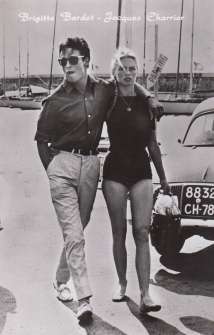
Brigitte Bardot and Jacques Charrier
Dutch postcard by Int. Filmpers, Amsterdam, no. 3500. Collection: Marlene Pilaete.The final 2023 La Collectionneuse post at European Film Star Postcards will go online on 30 December! Theme: Couples who were married in real life or who had had an affair.

Brigitte Bardot in Mio figlio Nerone (1956)
West German postcard by Kunst und Bild, Berlin-Charlottenburg, no. S 780. Photo: Union Film, Den Haag. Brigitte Bardot in Mio figlio Nerone / Nero's Mistress (Steno, 1956). The mural in the background is an imitation of the fresque in the Villa dei Misteri in Pompeii.Beautiful French actress Brigitte Bardot (1934) was the sex kitten of the European film industry. BB starred in 48 films, performed in numerous musical shows, and recorded 80 songs. After her retirement in 1973, she established herself as an animal rights activist and made vegetarianism sexy.Brigitte Bardot was born in Paris in 1934. Her father, Louis Bardot, had an engineering degree and worked with his father in the family business. Her mother, Ann-Marie Mucel, was 14 years younger than Brigitte's father and they married in 1933. Brigitte's mother encouraged her daughter to take up music and dance. At the age of 13, she entered the Conservatoire Nationale de Danse to study ballet. By the time she was 15, Brigitte was trying a modelling career and found herself in May 1949 on the cover of the French magazine Elle. Her incredible beauty was readily apparent, Brigitte was noticed by Roger Vadim, then an assistant to the film director Marc Allegrét. Vadim was infatuated with Bardot and encouraged her to start working as a film actress. BB was 18 when she debuted in the comedy Le Trou Normand/Crazy for Love (Jean Boyer, 1952). In the same year, she married Vadim. Brigitte wanted to marry him when she was 17, but her parents quashed any marriage plans until she turned 18. In April 1953 she attended the Cannes Film Festival where she received massive media attention. She soon was every man's idea of the girl he'd like to meet in Paris. From 1952 to 1956 she appeared in seventeen films. Her films were generally lightweight romantic dramas in which she was cast as an ingénue or siren, often with an element of undress. In 1953, she made her first US production, Un acte d'amour/Act of Love (Anatole Litvak, 1953) with Kirk Douglas, but she continued to make films in France.Roger Vadim was not content with the light fare his wife was offered. He felt Brigitte Bardot was being undersold. Looking for something more like an art film to push her as a serious actress, he showcased her in Et Dieu créa la femme/...And God Created Woman (Roger Vadim, 1956). This film, about an immoral teenager in a respectable small-town setting, was a smash success on both sides of the Atlantic. Craig Butler at AllMovie: "It's easy enough to say that ...And God Created Woman is much more important for its historical significance than for its actual quality as a film, and that's true to an extent. Woman's immense popularity, due to its willingness to directly embrace an exploration of sex as well as its willingness to show a degree of nudity that was remarkably daring for its day, demonstrated that audiences were willing to view subject matter that was considered too racy for the average moviegoer. This had both positive (freedom to explore, especially for the French filmmakers of the time) and negative (freedom to exploit) consequences, but its impact is undeniable. It's also true that Woman is not a great work of art, not with a story that is ultimately rather thin, some painful dialogue, and an attitude toward its characters and their sexuality that is unclear and inconsistent. Yet Woman is still fascinating, due in no small part to the presence of Brigitte Bardot in the role that made her an international star and sex symbol. She's not demonstrating great acting here, although her performance is actually good and much better than necessary, and her legendary mambo scene at the climax is nothing short of sensational." During the shooting of Et Dieu créa la femme/And God Created Woman (1956), directed by her husband Roger Vadim, Brigitte Bardot had an affair with her co-star Jean-Louis Trintignant, who at that time was married to French actress Stéphane Audran. Her divorce from Vadim followed, but they remained friends and collaborated in later work.Et Dieu créa la femme/...And God Created Woman (Roger Vadim, 1956) helped her international status. The film took the USA by storm, her explosive sexuality being unlike anything seen in the States since the days of the 'flapper' in the 1920s. It gave rise to the phrase 'sex kitten' and fascination of her in America consisted of magazine photographs and dubbed over French films - good, bad or indifferent, her films drew audiences - mainly men - into theatres like lemmings.BB appeared in light comedies like Doctor at Large (Ralph Thomas, 1957) - the third of the British 'Doctor' series starring Dirk Bogarde - and Une Parisienne/La Parisienne (Michel Boisrond, 1957) which suited her acting skills best. However, she was a sensation in the crime drama En cas de malheur/Love is My Profession (Claude Autant-Lara, 1958). Hal Erickson at AllMovie: "This Brigitte Bardot vehicle ran into stiff opposition from the Catholic Legion of Decency, severely limiting its U.S. distribution. Bardot plays a nubile small-time thief named Yvette, who becomes the mistress of influential defence attorney Andre (Jean Gabin). Though Andre is able to shower Yvette with jewels and furs, he cannot "buy" her heart, and thus it is that it belongs to handsome young student Mazzetti (Franco Interlenghi). Alas, Yvette is no judge of human nature: attractive though Mazzetti can be, he has a dangerous-and deadly-side. En Cas de Malheur contains a nude scene that has since been reprinted in freeze-frame form innumerable times by both film-history books and girlie magazines." Photographer Sam Lévin's photos contributed considerably to her image of sensuality and slight immorality. One of Lévin's pictures shows Brigitte, dressed in a white corset. It is said that around 1960 postcards with this photograph outsold in Paris those of the Eiffel Tower.Brigitte Bardot divorced Vadim in 1957 and in 1959 she married actor Jacques Charrier, with whom she starred in Babette s'en va-t-en guerre/Babette Goes to War (Christian-Jaque, 1959). The paparazzi preyed upon her marriage, while she and her husband clashed over the direction of her career. Her films became more substantial, but this brought a heavy pressure of dual celebrity as she sought critical acclaim while remaining a glamour model for most of the world. Vie privée/Private Life (1962), directed by Louis Malle has more than an element of autobiography in it. James Travers at French Films: "Brigitte Bardot hadn’t quite reached the highpoint of her career when she agreed to make this film with high profile New Wave film director Louis Malle. Even so, the pressure of being a living icon was obviously beginning to get to France’s sex goddess and Vie privée is as much an attempt by Bardot to come to terms with her celebrity as anything else. Malle is clearly fascinated by Bardot and the documentary approach he adopts for this film reinforces the impression that it is more a biography of the actress than a work of fiction. Of course it’s not entirely biographical, but the story is remarkably close to Bardot’s own life and comes pretty close to predicting how her career would end." The scene in which, returning to her apartment, Bardot's character is harangued in the elevator by a middle-aged cleaning lady calling her offensive names, was based on an actual incident, and is a resonant image of celebrity in the mid-20th century. Soon afterwards Bardot withdrew to the seclusion of Southern France.Brigitte Bardot's other husbands were German millionaire playboy Gunter Sachs and right-wing politician Bernard d'Ormale. She is reputed to have had relationships with many other men including Sami Frey, her co-star in La Vérité/The Truth (Henri-Georges Clouzot, 1960), and musicians Serge Gainsbourg and Sacha Distel. In 1963, Brigitte Bardot starred in Godard's critically acclaimed film Le Mépris/Contempt (Jean-Luc Godard, 1963). She was also featured along with such notable actors as Alain Delon in Amours célèbres/Famous Love Affairs (Michel Boisrond, 1961) and Histoires extraordinaires/Tales of Mystery (Louis Malle, 1968), Jeanne Moreau in Viva Maria! (Louis Malle, 1965), Sean Connery in Shalako (Edward Dmytryk, 1968), and Claudia Cardinale in Les Pétroleuses/Petroleum Girls (Christian-Jaque, 1971). She participated in various musical shows and recorded many popular songs in the 1960s and 1970s, mostly in collaboration with Serge Gainsbourg, Bob Zagury and Sacha Distel, including 'Harley Davidson', 'Le Soleil De Ma Vie' (the cover of Stevie Wonder's 'You Are the Sunshine of My Life') and the notorious 'Je t'aime... moi non plus'.Brigitte Bardot’s film career showed a steady decline in the late 1960s and early 1970s. In 1973 just before her fortieth birthday, she announced her retirement. She chose to use her fame to promote animal rights. In 1976 she established the Brigitte Bardot Foundation for the Welfare and Protection of Animals. She became a vegetarian and raised three million French francs to fund the foundation by auctioning off jewellery and many personal belongings. For this work, she was awarded the Légion d’honneur in 1984. During the 1990s she became also outspoken in her criticism of immigration, interracial relationships, Islam in France and homosexuality. Her husband Bernard d'Ormal is a former adviser of the far-right Front National party. Bardot has been convicted five times for 'inciting racial hatred'. More fun is that Bardot is recognised for popularising bikini swimwear, in such early films as Manina/Woman without a Veil (1952), in her appearances at Cannes and in many photo shoots. Bardot also brought into fashion the 'choucroute' ('Sauerkraut') hairstyle (a sort of beehive hairstyle) and gingham clothes after wearing a checkered pink dress, designed by Jacques Esterel, at her wedding to Charrier. The fashions of the 1960s looked effortlessly right and spontaneous on her. Time Magazine: "She is the princess of pout, the countess of come hither. Brigitte Bardot exuded a carefree, naïve sexuality that brought a whole new audience to French films."Sources: Denny Jackson (IMDb), Hal Erickson (AllMovie), Craig Butler (AllMovie), James Travers (French Films), French Films, Wikipedia and IMDb.And please check out our blog European Film Star Postcards.
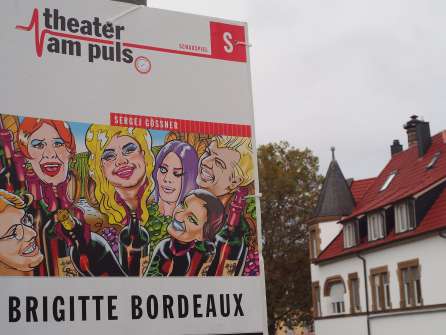
Plakat
53307847427_995f549d1d_b
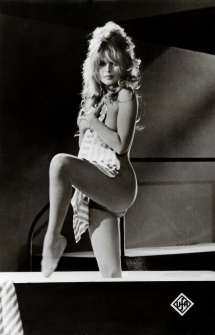
Brigitte Bardot
Dutch postcard by Gerbr. Spanjersberg N.V., Rotterdam, no. 1005. Photo: Ufa.Beautiful French actress Brigitte Bardot (1934) was the sex kitten of the European film industry. BB starred in 48 films, performed in numerous musical shows, and recorded 80 songs. After her retirement in 1973, she established herself as an animal rights activist and made vegetarianism sexy.And please check out our blog European Film Star Postcards.
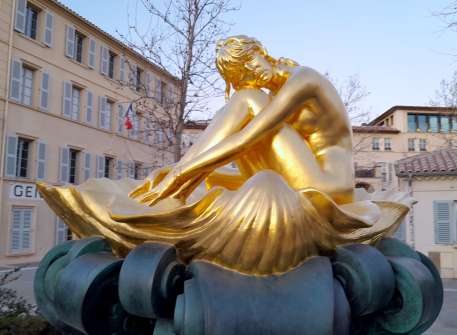
Saint-Tropez / l'iconique ''BB''
Oeuvre réalisée selon une aquarelle du maître italien de la bande dessinée érotique Milo Manara, elle-même inspirée par la fameuse ''Naissance de Vénus" de Botticelli.
Offerte à la cité à l'occasion des 83 ans de la star du cinéma des an-nées 60, la statue -de quelque 700kg et de 2,5m de hauteur- a été sculptée par des artisans italiens de renom, Liber Milian Garcia et Roberta Castellani, et réalisée par la fonderie Mariani de Pietrasanta (Italie),
Personnellement, je préférais la statue avant qu'elle ne soit dorée... Son nouvel aspect kitch me déplait totalement.

Saint-Tropez / Statue de Brigitte Bardot
Que serait Saint-Tropez sans le mythe de l'actrice au sommet de sa gloire et de sa beauté ?
S'inspirant d'une aquarelle du maître italien de la bande dessinée é-rotique Milo Manara, l'oeuvre, qui représente l'actrice sous l'effigie de la fameuse Vénus de Botticelli, a été inaugurée le 28 septembre 2017 sur la place Blanqui, juste devant l'ancienne gendarmerie de la ville, transformée en Musée de la Gendarmerie et du Cinéma.
Offerte à la cité à l'occasion des 83 ans de la star du cinéma des an-nées 60, la statue -de quelque 700kg et de 2,5m de hauteur- a été sculptée par des artisans italiens de renom (Liber Milian Garcia et Roberta Castellani) et réalisée par la fonderie Mariani de Pietrasanta (Italie),
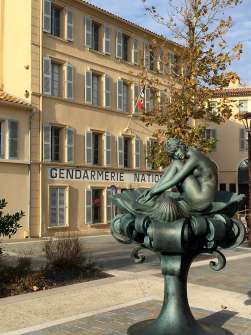
Saint-Tropez / Statue de Brigitte Bardot devant le Musée de la Gendarmerie et du Cinéma
Oeuvre réalisée selon une aquarelle du maître italien de la bande dessinée érotique Milo Manara, elle-même inspirée par la fameuse ''Naissance de Vénus" de Botticelli.
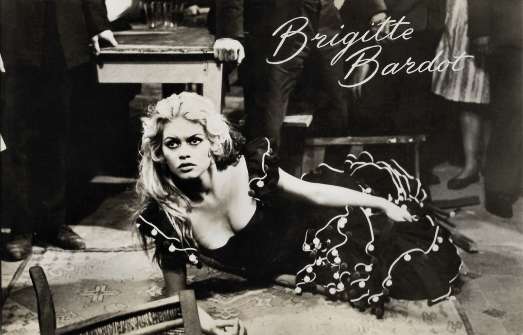
Brigitte Bardot in La femme et le pantin (1958)
Dutch postcard by Uitg. Takken, Utrecht, no. 3944. Photo: Pathé /N.V. City film, Den Haag. Brigitte Bardot in La femme et le pantin/The Female (Julien Duvivier, 1958).Beautiful French actress Brigitte Bardot (1934) was the sex kitten of the European film industry. BB starred in 48 films, performed in numerous musical shows, and recorded 80 songs. After her retirement in 1973, she established herself as an animal rights activist and made vegetarianism sexy.And please check out our blog European Film Star Postcards.
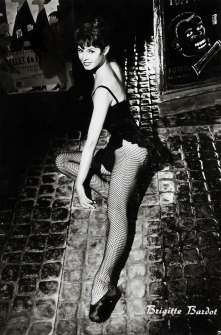
Brigitte Bardot on the set of Doctor at Sea (1955)
For Greg!Vintage postcard, no. 2043. Brigitte Bardot on the set of Doctor at Sea (Ralph Thomas, 1955).Beautiful French actress Brigitte Bardot (1934) was the sex kitten of the European film industry. BB starred in 48 films, performed in numerous musical shows, and recorded 80 songs. After her retirement in 1973, she established herself as an animal rights activist and made vegetarianism sexy.And please check out our blog European Film Star Postcards.
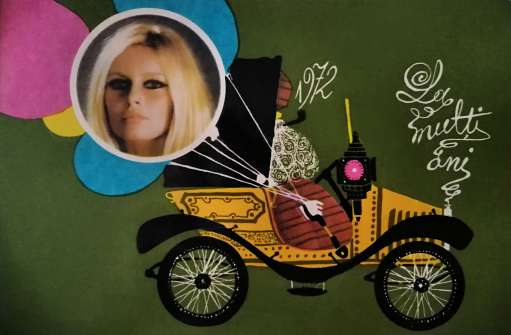
Brigitte Bardot, La multi ani 1972
Romanian postcard by Casa Filmului Acin, no. 106. Caption: La multi ani 1972. Collection: Alina Deaconu.Beautiful French actress Brigitte Bardot (1934) was the sex kitten of the European film industry. BB starred in 48 films, performed in numerous musical shows, and recorded 80 songs. After her retirement in 1973, she established herself as an animal rights activist and made vegetarianism sexy.Please, check out Alina's guest post at European Film Star Postcards, The Choice of Alina Deaconu.

Jean-Luc Godard
Films de Jean-Luc Godard
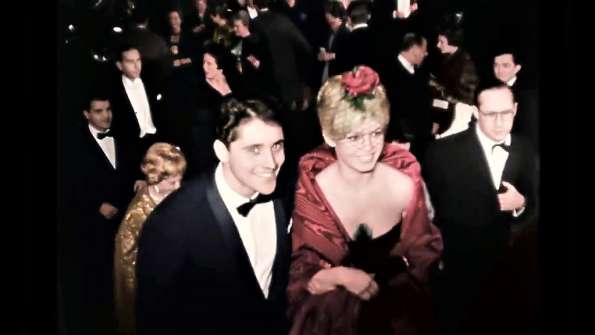
À l'Opéra de Paris, où Maria Callas donne un concert (décembre 1958)
52302922130_e9545b1907_b
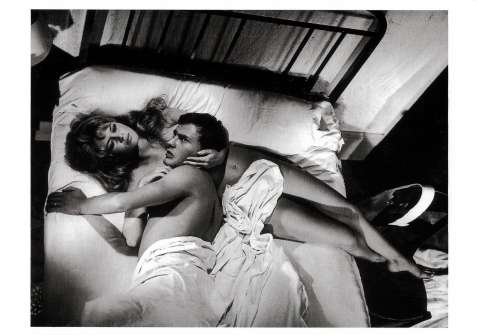
Jean-Louis Trintignant and Brigitte Bardot in Et Dieu crea la femme (1956)
Swiss postcard by News Productions, Baulmes / CVB Publishers, Grandson, no. 56783 Photo: Collection Cinémathèque Suisse, Lausanne. Jean-Louis Trintignant and Brigitte Bardot in Et Dieu... créa la femme/And God Created Woman (Roger Vadim, 1956).Jean-Louis Trintignant (1930) is one of the most talented and recognisable French actors of the post-war era. He showed a special talent for troubled characters like murderers or jealous husbands and won several awards for it. Trintignant starred in more than 100 films and enjoyed international acclaim with films like Et Dieu... créa la femme/And God Created Woman (1956), Un homme et une femme/A Man And A Woman (1966), Z (1969), Il Conformista/The Conformist (1970) and of course with Michael Haneke’s Amour/Love (2012). This year, Amour won the Academy Award for Best Foreign Film, and Jean-Louis Trintignant himself was awarded the César 2013 for Best Actor.Beautiful French actress Brigitte Bardot (1934) was the sex kitten of the European film industry. BB starred in 48 films, performed in numerous musical shows, and recorded 80 songs. After her retirement in 1973, she established herself as an animal rights activist and made vegetarianism sexy.And, please check out our blog European Film Star Postcards.

Brigitte Bardot and Yves Robert in Les Grandes Manoeuvres (1955)
Swiss-German-British postcard by News Productions, Baulmes / Filmwelt Berlin, Bakede / News Productions, Stroud, no. 56501. Photo: Collection Cinémathèque Suisse, Lausanne.Brigitte Bardot and Yves Robert in Les Grandes Manoeuvres/Summer Manoeuvres (René Clair, 1955), produced by Filmsonor and Rizzoli Films.Beautiful French actress Brigitte Bardot (1934) was the sex kitten of the European film industry. BB starred in 48 films, performed in numerous musical shows, and recorded 80 songs. After her retirement in 1973, she established herself as an animal rights activist and made vegetarianism sexy.Brigitte Bardot was born in Paris in 1934. Her father, Louis Bardot, had an engineering degree and worked with his father in the family business. Her mother, Ann-Marie Mucel, was 14 years younger than Brigitte's father and they married in 1933. Brigitte's mother encouraged her daughter to take up music and dance. At the age of 13, she entered the Conservatoire Nationale de Danse to study ballet. By the time she was 15, Brigitte was trying a modeling career and found herself in May 1949 on the cover of the French magazine Elle. Her incredible beauty was readily apparent, Brigitte was noticed by Roger Vadim, then an assistant to the film director Marc Allegrét. Vadim was infatuated with Bardot and encouraged her to start working as a film actress. BB was 18 when she debuted in the comedy Le Trou Normand/Crazy for Love (Jean Boyer, 1952). In the same year, she married Vadim. Brigitte wanted to marry him when she was 17, but her parents quashed any marriage plans until she turned 18. In April 1953 she attended the Cannes Film Festival where she received massive media attention. She soon was every man's idea of the girl he'd like to meet in Paris. From 1952 to 1956 she appeared in seventeen films. Her films were generally lightweight romantic dramas in which she was cast as ingénue or siren, often with an element of undress. She made her first US production in 1953 in Un acte d'amour/Act of Love (Anatole Litvak, 1953) with Kirk Douglas, but she continued to make films in France.Roger Vadim was not content with the light fare his wife was offered. He felt Brigitte Bardot was being undersold. Looking for something more like an art film to push her as a serious actress, he showcased her in Et Dieu créa la femme/...And God Created Woman (Roger Vadim, 1956). This film, about an immoral teenager in a respectable small-town setting, was a smashing success on both sides of the Atlantic. Craig Butler at AllMovie: "It's easy enough to say that ...And God Created Woman is much more important for its historical significance than for its actual quality as a film, and that's true to an extent. Woman's immense popularity, due to its willingness to directly embrace an exploration of sex as well as its willingness to show a degree of nudity that was remarkably daring for its day, demonstrated that audiences were willing to view subject matter that was considered too racy for the average moviegoer. This had both positive (freedom to explore, especially for the French filmmakers of the time) and negative (freedom to exploit) consequences, but its impact is undeniable. It's also true that Woman is not a great work of art, not with a story that is ultimately rather thin, some painful dialogue, and an attitude toward its characters and their sexuality that is unclear and inconsistent. Yet Woman is still fascinating, due in no small part to the presence of Brigitte Bardot in the role that made her an international star and sex symbol. She's not demonstrating great acting here, although her performance is actually good and much better than necessary, and her legendary mambo scene at the climax is nothing short of sensational." During the shooting of Et Dieu créa la femme/And God Created Woman (1956), directed by her husband Roger Vadim, Brigitte Bardot had an affair with her co-star Jean-Louis Trintignant, who at that time was married to French actress Stéphane Audran. Her divorce from Vadim followed, but they remained friends and collaborated in later work.Et Dieu créa la femme/...And God Created Woman (Roger Vadim, 1956) helped her international status. The film took the USA by storm, her explosive sexuality being unlike anything seen in the States since the days of the 'flapper' in the 1920s. It gave rise to the phrase 'sex kitten' and fascination of her in America consisted of magazine photographs and dubbed over French films - good, bad, or indifferent, her films drew audiences - mainly men - into theaters like lemmings.BB appeared in light comedies like Doctor at Large (1957) - the third of the British 'Doctor' series starring Dirk Bogarde - and Une Parisienne/La Parisienne (Michel Boisrond, 1957) which suited her acting skills best. However, she was a sensation in the crime drama En cas de malheur/Love is my profession (Claude Autant-Lara, 1958). Hal Erickson at AllMovie: "this Brigitte Bardot vehicle ran into stiff opposition from the Catholic Legion of Decency, severely limiting its U.S. distribution. Bardot plays a nubile small-time thief named Yvette, who becomes the mistress of influential defense attorney Andre (Jean Gabin). Though Andre is able to shower Yvette with jewels and furs, he cannot "buy" her heart, and thus it is that it belongs to handsome young student Mazzetti (Franco Interlenghi). Alas, Yvette is no judge of human nature: attractive though Mazzetti can be, he has a dangerous and deadly side. En Cas de Malheur contains a nude scene that has since been reprinted in freeze-frame form innumerable times by both film-history books and girlie magazines." Photographer Sam Lévin's photos contributed considerably to her image of sensuality and slight immorality. One of Lévin's pictures shows Brigitte, dressed in a white corset. It is said that around 1960 postcards with this photograph outsold in Paris those of the Eiffel Tower.Brigitte Bardot divorced Vadim in 1957 and in 1959 she married actor Jacques Charrier, with whom she starred in Babette s'en va-t-en guerre/Babette Goes to War (Christian-Jaque, 1959). The paparazzi preyed upon her marriage, while she and her husband clashed over the direction of her career. Her films became more substantial, but this brought a heavy pressure of dual celebrity as she sought critical acclaim while remaining a glamour model for most of the world. Vie privée/Private Life (1962), directed by Louis Malle has more than an element of autobiography in it. James Travers at Films de France: "Brigitte Bardot hadn’t quite reached the highpoint of her career when she agreed to make this film with high profile New Wave film director Louis Malle. Even so, the pressure of being a living icon was obviously beginning to get to France’s sex goddess and Vie privée is as much an attempt by Bardot to come to terms with her celebrity as anything else. Malle is clearly fascinated by Bardot and the documentary approach he adopts for this film reinforces the impression that it is more a biography of the actress than a work of fiction. Of course, it’s not entirely biographical, but the story is remarkably close to Bardot’s own life and comes pretty close to predicting how her career would end." The scene in which, returning to her apartment, Bardot's character is harangued in the elevator by a middle-aged cleaning lady calling her offensive names, was based on an actual incident and is a resonant image of a celebrity in the mid-20th century. Soon afterward Bardot withdrew to the seclusion of Southern France.Brigitte Bardot's other husbands were German millionaire playboy Gunter Sachs and right-wing politician Bernard d'Ormale. She is reputed to have had relationships with many other men including Sami Frey, her co-star in La Vérité/The Truth (Henri-Georges Clouzot, 1960), and musicians Serge Gainsbourg and Sacha Distel. In 1963, Brigitte Bardot starred in Godard's critically acclaimed film Le Mépris/Contempt (Jean-Luc Godard, 1963). She was also featured along with such notable actors as Alain Delon in Amours célèbres/Famous Love Affairs (Michel Boisrond, 1961) and Histoires extraordinaires/Tales of Mystery (Louis Malle, 1968), Jeanne Moreau in Viva Maria! (Louis Malle, 1965), Sean Connery in Shalako (Edward Dmytryk, 1968), and Claudia Cardinale in Les Pétroleuses/Petroleum Girls (Christian-Jaque, 1971). She participated in various musical shows and recorded many popular songs in the 1960s and 1970s, mostly in collaboration with Serge Gainsbourg, Bob Zagury, and Sacha Distel, including 'Harley Davidson', 'Le Soleil De Ma Vie' (the cover of Stevie Wonder's 'You Are the Sunshine of My Life') and the notorious 'Je t'aime... moi non plus'.Brigitte Bardot’s film career showed a steady decline in the late 1960s and early 1970s. In 1973 just before her fortieth birthday, she announced her retirement. She chose to use her fame to promote animal rights. In 1976 she established the Brigitte Bardot Foundation for the Welfare and Protection of Animals. She became a vegetarian and raised three million French francs to fund the foundation by auctioning off jewelry and many personal belongings. For this work, she was awarded the Légion d’honneur in 1984. During the 1990's she became also outspoken in her criticism of immigration, interracial relationships, Islam in France, and homosexuality. Her husband Bernard d'Ormal is a former adviser of the far-right Front National party. Bardot has been convicted five times for 'inciting racial hatred'. More fun is that Bardot is recognised for popularizing bikini swimwear, in early films such as Manina/Woman without a Veil (1952), in her appearances at Cannes and in many photoshoots. Bardot also brought into fashion the 'choucroute' ('Sauerkraut') hairstyle (a sort of beehive hairstyle) and gingham clothes after wearing a checkered pink dress, designed by Jacques Esterel, at her wedding to Charrier. The fashions of the 1960s looked effortlessly right and spontaneous on her. Time Magazine: "She is the princess of pout, the countess of come hither. Brigitte Bardot exuded a carefree, naïve sexuality that brought a whole new audience to French films."Sources: Denny Jackson (IMDb), Hal Erickson (AllMovie), Craig Butler (AllMovie), James Travers (Films de France), Films de France, Wikipedia, and IMDb.And, please check out our blog European Film Star Postcards.
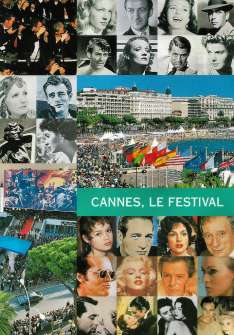
Cannes Film Festival
French postcard by Images - Distribution. Image: Photos D.R. Caption: Cannes (Alpes-Maritimes) Le Festival.Every year, in the third week of May, international filmmakers, stars, film industry professionals and thousands of journalists go to the Côte d'Azur. They visit the most prestigious film festival in the world, the Cannes Film Festival (Festival de Cannes).The Cannes Film Festival has been held every year in the French city of Cannes since 1946. The venue is the Palais des Festivals et des Congrès on the La Croisette promenade. The most important prize awarded at Cannes is the Palme d'Or (Golden Palm) for the best film in the International Competition. The Golden Palm is sometimes shared by several films in the same year. Other prizes awarded by the jury for the film as a whole are (in descending order) the Grand Prize of the Jury (Grand prix du jury), the Prize of the Jury (Prix du Jury) and the Special Prize of the Jury (not necessarily awarded every year). There are also prizes in the individual categories of female actor, male actor, director and screenplay. The awards in Cannes are given by a jury made up of several people, usually experienced and award-winning professionals from the film industry. Other juries also award competition films here. The most important are the FIPRESCI Prize of International Film Critics (Prix de la FIPRESCI) and the Ecumenical Jury Prize (Prix du Jury oecuménique). In addition to the main competition, there is also the short film competition with the Palme d'Or for short films (Palme d'Or du court métrage), the Cinéfondation competition, in which works by film students are awarded, as well as the Un Certain Regard series, in which the Prix Un Certain Regard has been awarded since 1998. Within the framework of the international film festival, both the directors' association Société des Réalisateurs de Films with its La Quinzaine des Réalisateurs and the critics' organisation Syndicat français de la critique de cinéma with its La Semaine Internationale de la Critique hold their own independent parallel event at which a number of prizes are also awarded.The Cannes Film Festival receives a lot of media attention, it is attended by many film stars and is a popular opportunity for film producers to present their new films and sell them to distributors. The film stars are transported in luxurious limousines to the famous red carpet, where they climb the "24 stairs to glory" and to be hidden from public view. From the 1950s onwards, Cannes became the biggest event in world cinema. Gradually, as the critic André Bazin wished, the festival became more concerned with cinema and less with mundanities, patriotism and diplomacy. Until the 1970s, embassies presented the films chosen by their governments. Major filmmakers presented major works at the festival: Roberto Rossellini, Federico Fellini, Ingmar Bergman, Elia Kazan, Joseph L. Mankiewicz, Robert Wise, William Wyler, Michelangelo Antonioni, Vittorio De Sica, Andrzej Wajda, Satyajit Ray, Luis Buñuel and Akira Kurosawa. In 1997, on the occasion of the 50th Cannes Film Festival, Ingmar Bergman was awarded the "Palm of Palms" in the presence of many previous winners.In 2012 the president of the Festival at the time, Gilles Jacob,expressed a regret about the monumentality of the event, which had lost its humanity compared to the time when Kirk Douglas played football with journalists and the stars walked to the beach: "The Festival should stop growing, so as not to become an embarrassment. Cannes is the most beautiful city for a film festival, but it must remain a pleasure, not a constraint. [...] There are more and more people and media who want to come, we can't forbid them. [...] When the stars come down to the bottom of the steps, some talk to people, others don't. Many give nothing but the usual, devote themselves to their work. Many just give the agreed upon, spend a short day with the press, and leave. It's almost like a factory."The Cannes Film Festival was conceived on the initiative of the French Minister of Education and Culture, Jean Zay. Originally planned for 1939, the first Cannes International Film Festival took place for the first time from 20 September to 5 October 1946 due to the Second World War. In 1948 and 1950, the festival was cancelled due to financing difficulties. In 1955, the best film was awarded the Palme d'Or for the first time. The trophy, designed by French jeweller Lucienne Lazon, replaced the "Grand Prix" which had been awarded until then. As a result of the Paris May riots, the 1968 festival was cancelled on 19 May. Louis Malle had already resigned as a member of the jury the evening before. Malle, François Truffaut, Claude Berri, Jean-Gabriel Albicocco, Claude Lelouch, Roman Polański and Jean-Luc Godard invaded the Great Hall of the Palais des Festivals and demanded the interruption of the screening as a show of solidarity with the striking workers and students. The action was also seen as a response to the dismissal of Henri Langlois as director of the Cinémathèque française shortly before. In 2014, Gilles Jacob became honorary president after 38 years of directing the Festival, his successor is Pierre Lescure. The Film Market facilitates exchanges between buyers and sellers in the film industry and has become the world's leading platform for the international film trade. In 2007, it hosted over 10,000 participants from 91 countries. In 2017, the festival celebrated its 70th edition, inviting award-winning filmmakers and screenings of series by great filmmakers. Today, the official selection is intended to reflect the world's film production. The competition generally highlights auteur or research films. The question of creating an award for original music has been raised.Sources: Wikipedia (French, Dutch and German).And please check out our blog European Film Star Postcards.
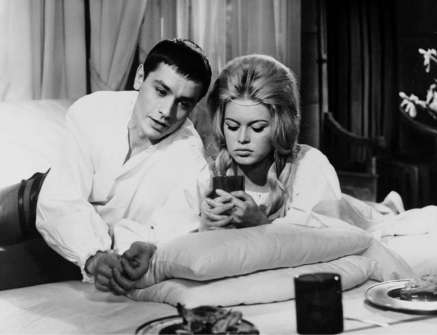
Alain Delon and Brigitte Bardot in "Les Amours Celebres". (1961).
51752726472_0dc7b2226d_b
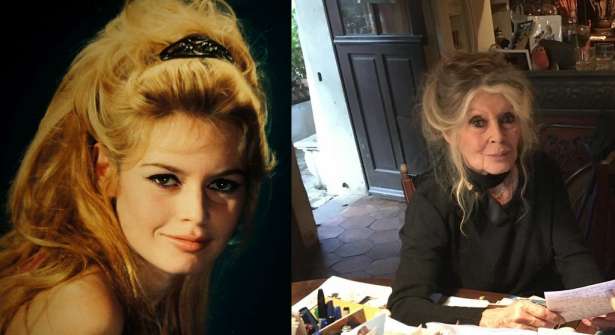
Happy 87th Birthday, Brigitte Bardot. (Born 28 September 1934).
1960s and 2018.
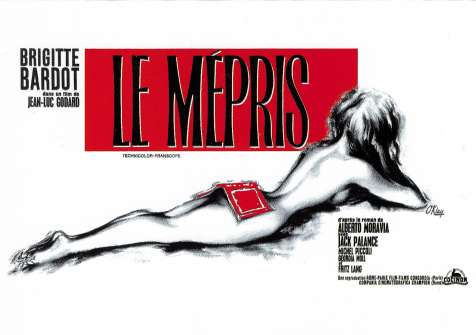
Le Mépris (1963)
French postcard by BS, no. 31, 2005. French poster for Le Mépris/Contempt (Jean-Luc Godard, 1963) starring Brigitte Bardot. Poster design: Pierre Okley, 1963.Jean-Luc Godard (1930) is a French film director and screenwriter. He is one of the most important members of the Nouvelle Vague (New Wave). Godard first received global acclaim for his feature À bout de souffle/Breathless (1959), helping to establish the New Wave movement. Godard's films have inspired many directors including Martin Scorsese, Quentin Tarantino, Robert Altman, Rainer Werner Fassbinder, and Wong Kar-wai. He has been married twice, to actresses Anna Karina and Anne Wiazemsky, both of whom starred in several of his films.Jean-Luc Godard was born in Paris in 1930. His father was a doctor who owned a private clinic, and his mother came from a preeminent family of Swiss bankers. The family returned to Switzerland during World War II. In 1949 he started studying ethnology at the Sorbonne. During this period he got to know François Truffaut, Jacques Rivette and Éric Rohmer. In 1950 he started a film newspaper 'Gazette du cinéma' with Rivette and Rohmer and collaborated on their films. In January 1952 he started writing for the film magazine 'Les cahiers du cinéma', which had been founded the year before by André Bazin. In 1953 he worked as a construction worker at a dam in Switzerland. With the money he earned, he made his first film, Opération Béton/Operation Concrete, a short documentary film about the construction of the dam. In 1956 he returned to France and resumed his work at Cahiers. During that time he made several short comedies and tributes to Mack Sennett and Jean Cocteau. In 1959 he directed his first feature film, À bout de souffle/Breathless (1960), based on a screenplay by François Truffaut. This film played a key role in the birth of the Nouvelle Vague. It broke with many then prevailing conventions, with its references and influences from the American (gangster) film, the low budget, and the rough editing. Jean-Paul Belmondo and Jean Seberg starred and the film was a huge success with audiences and critics. Godard won the Silver Bear for this film at the Berlin Film Festival 1960. Jean Seberg was nominated for a BAFTA Award. That year Godard also married Anna Karina, who would appear in many of his films. In 1964 they formed a production company, Anouchka Films. They divorced in 1965.In 1961 Jean-Luc Godard made his first colour film, the comedy Une femme est une femme/A Woman Is a Woman (1961) starring Anna Karina, Jean-Claude Brialy, and Jean-Paul Belmondo. It is a tribute to American musical comedy, filmed in cinemascope. Godard proved to be very productive during those years. His first flop, the war film Les Carabiniers/The Carabineers (1963), was a tribute to Jean Vigo. That year he also made one of his greatest successes, Le Mépris/Contempt (1963) with Brigitte Bardot, Michel Piccoli, Jack Palance, and Fritz Lang. Then followed Bande à part/Band of Outsiders (1964) with Anna Karina and Sami Frey, Pierrot le fou/Crazy Pierrot (1965) with Jean-Paul Belmondo and Anna Karina, and the Science-Fiction film Alphaville/Alphaville: A Strange Adventure of Lemmy Caution (1965) with Eddie Constantine. The film won the Golden Bear award of the 15th Berlin International Film Festival in 1965. Other films from those years were Masculin, feminin (1966) with Jean-Pierre Léaud, and Week-end (1967) with Mireille Darc. Around the student uprisings of 1968, Godard became interested in Maoism. At that time he started an experimental political phase, which lasted until 1980. In the summer of 1968, together with Jean-Pierre Gorin, among others, he founded the Dziga Vertov Group, which wanted to make "political films political". Some films from that time are Le Gai Savoir (1968), Pravda and One Plus One/Sympathy for the Devil (1968), the latter of which includes a unique recording of the studio build-up by the Rolling Stones of the classic Sympathy for the Devil. In 1972 he made Tout va bien (1972), with Jane Fonda and Yves Montand in the lead roles, followed by Letter to Jane, a film about a photograph of Jane Fonda, which Gorin and Godard discuss. In 1972 he also met Anne-Marie Miéville, his later wife, with whom he made many films. This phase ended in 1980.After twelve years of low budget, militant left-wing, and otherwise experimental film and video projects outside of commercial distribution, Jean-Luc Godard's first film that was more mainstream and accessible again was the drama Sauve qui peut (la vie)/Every Man for Himself (1980) with Isabelle Huppert, Jacques Dutronc, and Nathalie Baye. His films after that time are more autobiographical. For example, in Sauve qui peut (la vie)/Every Man for Himself there was a character named Godard. In 1982 and 1983 he made three related films Passion (1982), Prénom Carmen (1983) and Je vous salue, Marie (1984). The latter film was dismissed as blasphemy by the Catholic Church. The film King Lear (1987), which he made with Norman Mailer, also caused controversy. It was a bizarre postmodern take on the Shakespeare play, with theatre director Peter Sellars as a descendant of Shakespeare, Burgess Meredith as the mobster Don Learo, Jean-Luc Godard as the professor, and Woody Allen as a character called Mr. Alien. Not entirely coincidentally, Mr. Alien was also nicknamed Jean-Luc Godard. From 1989 to 1998, he made the series Histoire(s) du Cinéma, about the twentieth century and the history of film. His most recent film is the avantgarde essay Le Livre d'image/The Image Book (2018).Sources: Wikipedia (Dutch and English), and IMDb.And, please check out our blog European Film Star Postcards.
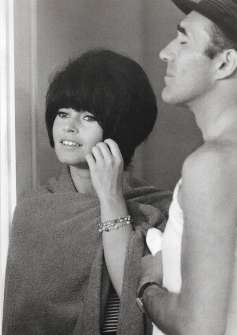
Brigitte Bardot and Michel Piccoli in Le Mépris (1963)
French postcard in the Collection Cinéma series by Editions Art & Scène, Paris, no. CF 101, 1996. Brigitte Bardot and Michel Piccoli in Le Mépris(Jean-Luc Godard, 1963).Beautiful French actress Brigitte Bardot (1934) was the sex kitten of the European film industry. BB starred in 48 films, performed in numerous musical shows, and recorded 80 songs. After her retirement in 1973, she established herself as an animal rights activist and made vegetarianism sexy.Michel Piccoli (1925-2020) was one of the most original and versatile French actors of the last half-century. He appeared in many different roles, from seducer to cop to a gangster to Pope in more than 200 films and TV films. Among the directors he worked with are Jean Renoir, Jean-Pierre Melville, Jean-Luc Godard, Agnès Varda, Luis Buñuel, and Alfred Hitchcock.And, please check out our blog European Film Star Postcards.
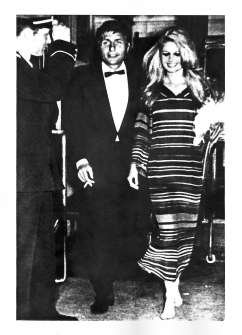
Guess Who
Small Dutch collectors card.Yes, Martha Hyer was yesterday's star on the tiger skin! Jim, Sophia and Agnieszka, you were all right. Well done! For today, I've uploaded 5 cards. The beautiful woman on all the cards is an easy guess: it's BB! But who is the guy with whom Brigitte Bardot is walking hand-in-hand on two of the cards. One clue: he was not an actor! Good luck and share your thoughts in a comment.About the cards: they must date from the early 1960s. We think someone took photos of magazine pictures. According to the seller at Marktplaats, all the photos had been published in Dutch Oh-la-la magazines like De Lach, in English 'The Smile'. A little anecdote: as young kids in the 1960s, Truus and I read 'De Lach' at home. Our parents received these magazines from our grandmother. Grandma never read them, but out of pity for the man who sold the magazines, she refused to cancel the subscription and gave the magazines to my father. As young kids, Truus and I loved the magazines too, and like serious beauty-contestant judges, we gave all the models numbers for who we liked best.Greetings from Amsterdam, BobAnd, please check out our blog European Film Star Postcards.
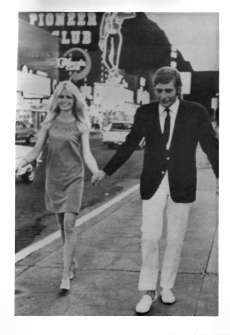
Guess Who
Small Dutch collectors card.Yes, Martha Hyer was yesterday's star on the tiger skin! Jim, Sophia and Agnieszka, you were all right. Well done! For today, I've uploaded 5 cards. The beautiful woman on all the cards is an easy guess: it's BB! But who is the guy with whom Brigitte Bardot is walking hand-in-hand on two of the cards. One clue: he was not an actor! Good luck and share your thoughts in a comment.About the cards: they must date from the early 1960s. We think someone took photos of magazine pictures. According to the seller at Marktplaats, all the photos had been published in Dutch Oh-la-la magazines like De Lach, in English 'The Smile'. A little anecdote: as young kids in the 1960s, Truus and I read 'De Lach' at home. Our parents received these magazines from our grandmother. Grandma never read them, but out of pity for the man who sold the magazines, she refused to cancel the subscription and gave the magazines to my father. As young kids, Truus and I loved the magazines too, and like serious beauty-contestant judges, we gave all the models numbers for who we liked best.Greetings from Amsterdam, BobAnd, please check out our blog European Film Star Postcards.
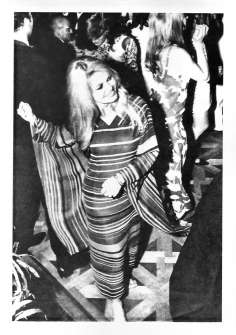
Guess Who
Small Dutch collectors card.Yes, Martha Hyer was yesterday's star on the tiger skin! Jim, Sophia and Agnieszka, you were all right. Well done! For today, I've uploaded 5 cards. The beautiful woman on all the cards is an easy guess: it's BB! But who is the guy with whom Brigitte Bardot is walking hand-in-hand on two of the cards. One clue: he was not an actor! Good luck and share your thoughts in a comment.About the cards: they must date from the early 1960s. We think someone took photos of magazine pictures. According to the seller at Marktplaats, all the photos had been published in Dutch Oh-la-la magazines like De Lach, in English 'The Smile'. A little anecdote: as young kids in the 1960s, Truus and I read 'De Lach' at home. Our parents received these magazines from our grandmother. Grandma never read them, but out of pity for the man who sold the magazines, she refused to cancel the subscription and gave the magazines to my father. As young kids, Truus and I loved the magazines too, and like serious beauty-contestant judges, we gave all the models numbers for who we liked best.Greetings from Amsterdam, BobAnd, please check out our blog European Film Star Postcards.

Guess Who
Small Dutch collectors card.Yes, Martha Hyer was yesterday's star on the tiger skin! Jim, Sophia and Agnieszka, you were all right. Well done! For today, I've uploaded 5 cards. The beautiful woman on all the cards is an easy guess: it's BB! But who is the guy with whom Brigitte Bardot is walking hand-in-hand on two of the cards. One clue: he was not an actor! Good luck and share your thoughts in a comment.About the cards: they must date from the early 1960s. We think someone took photos of magazine pictures. According to the seller at Marktplaats, all the photos had been published in Dutch Oh-la-la magazines like De Lach, in English 'The Smile'. A little anecdote: as young kids in the 1960s, Truus and I read 'De Lach' at home. Our parents received these magazines from our grandmother. Grandma never read them, but out of pity for the man who sold the magazines, she refused to cancel the subscription and gave the magazines to my father. As young kids, Truus and I loved the magazines too, and like serious beauty-contestant judges, we gave all the models numbers for who we liked best.Greetings from Amsterdam, BobAnd, please check out our blog European Film Star Postcards.
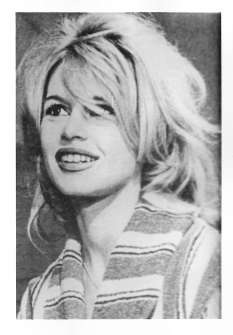
Guess Who
Small Dutch collectors card.Yes, Martha Hyer was yesterday's star on the tiger skin! Jim, Sophia and Agnieszka, you were all right. Well done! For today, I've uploaded 5 cards. The beautiful woman on all the cards is an easy guess: it's BB! But who is the guy with whom Brigitte Bardot is walking hand-in-hand on two of the cards. One clue: he was not an actor! Good luck and share your thoughts in a comment.About the cards: they must date from the early 1960s. We think someone took photos of magazine pictures. According to the seller at Marktplaats, all the photos had been published in Dutch Oh-la-la magazines like De Lach, in English 'The Smile'. A little anecdote: as young kids in the 1960s, Truus and I read 'De Lach' at home. Our parents received these magazines from our grandmother. Grandma never read them, but out of pity for the man who sold the magazines, she refused to cancel the subscription and gave the magazines to my father. As young kids, Truus and I loved the magazines too, and like serious beauty-contestant judges, we gave all the models numbers for who we liked best.Greetings from Amsterdam, BobAnd, please check out our blog European Film Star Postcards.
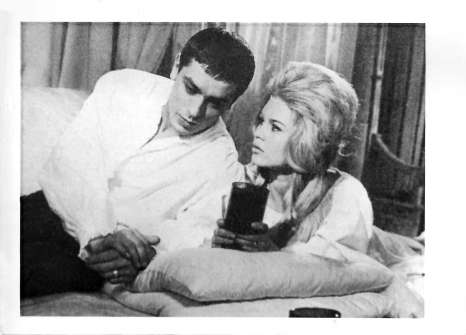
Guess Who
Small Dutch collectors card.For once we have two stars in 'Guess who'. We think this picture is an easy one. Who are these two gorgeous people? Let us know your thoughts in the comments.About the cards: they must date from the early 1960s. We think someone took photos of magazine pictures. According to the seller at Marktplaats, all the photos had been published in Dutch Oh-la-la magazines like De Lach, in English 'The Smile'. A little anecdote: as young kids in the 1960s, Truus and I read 'De Lach' at home. My parents received these magazines from our grandmother. Grandma never read them, but out of pity for the man who sold the magazines, she refused to cancel the subscription and gave the magazines to my father. As young kids, Truus and I loved the magazines too, and like serious beauty-contestant judges, we gave all the models numbers for who we liked best. Join the fun and guess who this film star is. And you may give her a number too!Greetings from Amsterdam, BobAnd, please check out our blog European Film Star Postcards.
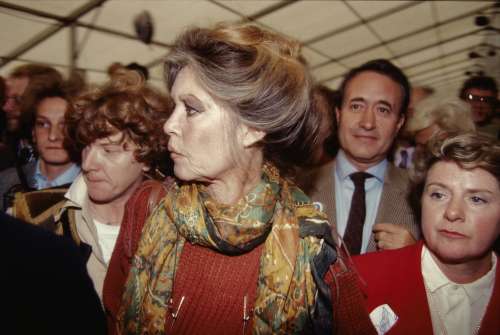
Paris 12. Hippodrome de Vincennes
1 Octobre 1989
Diapositive numérisée.
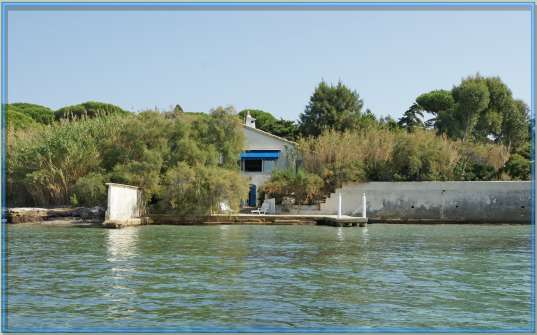
La Madrague
la maison de Brigitte Bardot
see and hear her here
www.youtube.com/watch?v=Fchy_Gu3PFk
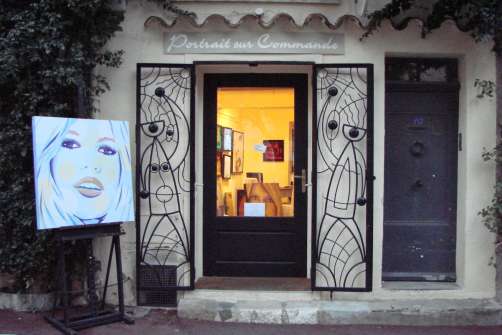
Gallerie in Saint Tropez
264155319_90f81e94d4_b

Brigitte - for ever young
6336709931_94fc98bb0b_b
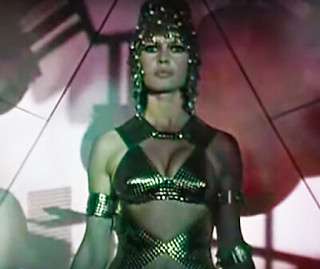
Happy 86th Birthday, Brigitte Bardot. 28 September 1934.
Here is a music video created for her 1968 television special.
She performs the Serge Gainsbourg-written CONTACT.
www.austinfilm.org/2015/09/watch-this-brigitte-bardot-and...
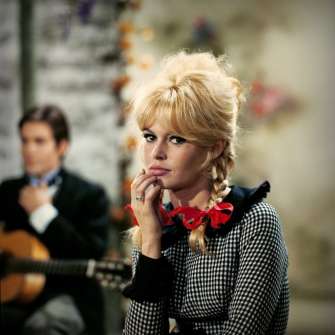
Happy Birthday BB. 28 September 1934.
48805318616_bf71b025ac_b
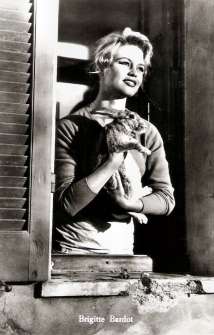
Brigitte Bardot in Et Dieu... créa la femme (1956)
Dutch postcard by Gebr. Spanjersberg N.V., Rotterdam. sent by mail in 1963. Brigitte Bardot in Et Dieu... créa la femme/...And God Created Woman (Roger Vadim, 1956).Beautiful French actress Brigitte Bardot (1934) was the sex kitten of the European film industry. BB starred in 48 films, performed in numerous musical shows, and recorded 80 songs. After her retirement in 1973, she established herself as an animal rights activist and made vegetarianism sexy.Brigitte Bardot was born in Paris in 1934. Her father, Louis Bardot, had an engineering degree and worked with his father in the family business. Her mother, Ann-Marie Mucel, was 14 years younger than Brigitte's father and they married in 1933. Brigitte's mother encouraged her daughter to take up music and dance. At the age of 13, she entered the Conservatoire Nationale de Danse to study ballet. By the time she was 15, Brigitte was trying a modelling career and found herself in May 1949 on the cover of French magazine Elle. Her incredible beauty was readily apparent, Brigitte was noticed by Roger Vadim, then an assistant to the film director Marc Allegrét. Vadim was infatuated with Bardot and encouraged her to start working as a film actress. BB was 18 when she debuted in the comedy Le Trou Normand/Crazy for Love (Jean Boyer, 1952). In the same year, she married Vadim. Brigitte wanted to marry him when she was 17, but her parents quashed any marriage plans until she turned 18. In April 1953 she attended the Cannes Film Festival where she received massive media attention. She soon was every man's idea of the girl he'd like to meet in Paris. From 1952 to 1956 she appeared in seventeen films. Her films were generally lightweight romantic dramas in which she was cast as ingénue or siren, often with an element of undress. She made her first US production in 1953 in Un acte d'amour/Act of Love (Anatole Litvak, 1953) with Kirk Douglas, but she continued to make films in France.Roger Vadim was not content with the light fare his wife was offered. He felt Brigitte Bardot was being undersold. Looking for something more like an art film to push her as a serious actress, he showcased her in Et Dieu créa la femme/...And God Created Woman (Roger Vadim, 1956). This film, about an immoral teenager in a respectable small-town setting, was a smashing success on both sides of the Atlantic. Craig Butler at AllMovie: "It's easy enough to say that ...And God Created Woman is much more important for its historical significance than for its actual quality as a film, and that's true to an extent. Woman's immense popularity, due to its willingness to directly embrace an exploration of sex as well as its willingness to show a degree of nudity that was remarkably daring for its day, demonstrated that audiences were willing to view subject matter that was considered too racy for the average moviegoer. This had both positive (freedom to explore, especially for the French filmmakers of the time) and negative (freedom to exploit) consequences, but its impact is undeniable. It's also true that Woman is not a great work of art, not with a story that is ultimately rather thin, some painful dialogue, and an attitude toward its characters and their sexuality that is unclear and inconsistent. Yet Woman is still fascinating, due in no small part to the presence of Brigitte Bardot in the role that made her an international star and sex symbol. She's not demonstrating great acting here, although her performance is actually good and much better than necessary, and her legendary mambo scene at the climax is nothing short of sensational." During the shooting of Et Dieu créa la femme/And God Created Woman (1956), directed by her husband Roger Vadim, Brigitte Bardot had an affair with her co-star Jean-Louis Trintignant, who at that time was married to French actress Stéphane Audran. Her divorce from Vadim followed, but they remained friends and collaborated in later work.Et Dieu créa la femme/...And God Created Woman (Roger Vadim, 1956) helped her international status. The film took the USA by storm, her explosive sexuality being unlike anything seen in the States since the days of the 'flapper' in the 1920s. It gave rise to the phrase 'sex kitten' and fascination of her in America consisted of magazines photographs and dubbed over French films - good, bad, or indifferent, her films drew audiences - mainly men - into theaters like lemmings.BB appeared in light comedies like Doctor at Large (1957) - the third of the British 'Doctor' series starring Dirk Bogarde - and Une Parisienne/La Parisienne (Michel Boisrond, 1957) which suited her acting skills best. However, she was a sensation in the crime drama En cas de malheur/Love is my profession (Claude Autant-Lara, 1958). Hal Erickson at AllMovie: "this Brigitte Bardot vehicle ran into stiff opposition from the Catholic Legion of Decency, severely limiting its U.S. distribution. Bardot plays a nubile small-time thief named Yvette, who becomes the mistress of influential defense attorney Andre (Jean Gabin). Though Andre is able to shower Yvette with jewels and furs, he cannot "buy" her heart, and thus it is that it belongs to handsome young student Mazzetti (Franco Interlenghi). Alas, Yvette is no judge of human nature: attractive though Mazzetti can be, he has a dangerous-and deadly-side. En Cas de Malheur contains a nude scene that has since been reprinted in freeze-frame form innumerable times by both film-history books and girlie magazines." Photographer Sam Lévin's photos contributed considerably to her image of sensuality and slight immorality. One of Lévin's pictures shows Brigitte, dressed in a white corset. It is said that around 1960 postcards with this photograph outsold in Paris those of the Eiffel Tower.Brigitte Bardot divorced Vadim in 1957 and in 1959 she married actor Jacques Charrier, with whom she starred in Babette s'en va-t-en guerre/Babette Goes to War (Christian-Jaque, 1959). The paparazzi preyed upon her marriage, while she and her husband clashed over the direction of her career. Her films became more substantial, but this brought a heavy pressure of dual celebrity as she sought critical acclaim while remaining a glamour model for most of the world. Vie privée/Private Life (1962), directed by Louis Malle has more than an element of autobiography in it. James Travers at Films de France: "Brigitte Bardot hadn’t quite reached the highpoint of her career when she agreed to make this film with high profile New Wave film director Louis Malle. Even so, the pressure of being a living icon was obviously beginning to get to France’s sex goddess and Vie privée is as much an attempt by Bardot to come to terms with her celebrity as anything else. Malle is clearly fascinated by Bardot and the documentary approach he adopts for this film reinforces the impression that it is more a biography of the actress than a work of fiction. Of course, it’s not entirely biographical, but the story is remarkably close to Bardot’s own life and comes pretty close to predicting how her career would end." The scene in which, returning to her apartment, Bardot's character is harangued in the elevator by a middle-aged cleaning lady calling her offensive names, was based on an actual incident and is a resonant image of a celebrity in the mid-20th century. Soon afterward Bardot withdrew to the seclusion of Southern France.Brigitte Bardot's other husbands were German millionaire playboy Gunter Sachs and right-wing politician Bernard d'Ormale. She is reputed to have had relationships with many other men including Sami Frey, her co-star in La Vérité/The Truth (Henri-Georges Clouzot, 1960), and musicians Serge Gainsbourg and Sacha Distel. In 1963, Brigitte Bardot starred in Godard's critically acclaimed film Le Mépris/Contempt (Jean-Luc Godard, 1963). She was also featured along with such notable actors as Alain Delon in Amours célèbres/Famous Love Affairs (Michel Boisrond, 1961) and Histoires extraordinaires/Tales of Mystery (Louis Malle, 1968), Jeanne Moreau in Viva Maria! (Louis Malle, 1965), Sean Connery in Shalako (Edward Dmytryk, 1968), and Claudia Cardinale in Les Pétroleuses/Petroleum Girls (Christian-Jaque, 1971). She participated in various musical shows and recorded many popular songs in the 1960s and 1970s, mostly in collaboration with Serge Gainsbourg, Bob Zagury and Sacha Distel, including 'Harley Davidson', 'Le Soleil De Ma Vie' (the cover of Stevie Wonder's 'You Are the Sunshine of My Life') and the notorious 'Je t'aime... moi non plus'.Brigitte Bardot’s film career showed a steady decline in the late 1960s and early 1970s. In 1973 just before her fortieth birthday, she announced her retirement. She chose to use her fame to promote animal rights. In 1976 she established the Brigitte Bardot Foundation for the Welfare and Protection of Animals. She became a vegetarian and raised three million French francs to fund the foundation by auctioning off jewelry and many personal belongings. For this work, she was awarded the Légion d’honneur in 1984. During the 1990's she became also outspoken in her criticism of immigration, interracial relationships, Islam in France, and homosexuality. Her husband Bernard d'Ormal is a former adviser of the far-right Front National party. Bardot has been convicted five times for 'inciting racial hatred'. More fun is that Bardot is recognised for popularizing bikini swimwear, in early films such as Manina/Woman without a Veil (1952), in her appearances at Cannes and in many photoshoots. Bardot also brought into fashion the 'choucroute' ('Sauerkraut') hairstyle (a sort of beehive hairstyle) and gingham clothes after wearing a checkered pink dress, designed by Jacques Esterel, at her wedding to Charrier. The fashions of the 1960s looked effortlessly right and spontaneous on her. Time Magazine: "She is the princess of pout, the countess of come hither. Brigitte Bardot exuded a carefree, naïve sexuality that brought a whole new audience to French films."Sources: Denny Jackson (IMDb), Hal Erickson (AllMovie), Craig Butler (AllMovie), James Travers (Films de France), Films de France, Wikipedia, and IMDb.And, please check out our blog European Film Star Postcards.
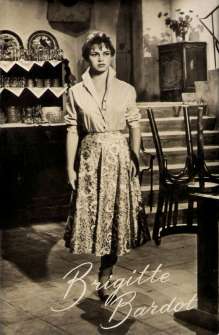
Brigitte Bardot in La lumière d'en face (1955)
Dutch postcard by Uitgeverij Takken, Utrecht, no. AX 3061. Brigitte Bardot in La lumière d'en face/The Light Across the Street (Georges Lacombe, 1955).Beautiful French actress Brigitte Bardot (1934) was the sex kitten of the European film industry. BB starred in 48 films, performed in numerous musical shows, and recorded 80 songs. After her retirement in 1973, she established herself as an animal rights activist and made vegetarianism sexy.Brigitte Bardot was born in Paris in 1934. Her father, Louis Bardot, had an engineering degree and worked with his father in the family business. Her mother, Ann-Marie Mucel, was 14 years younger than Brigitte's father and they married in 1933. Brigitte's mother encouraged her daughter to take up music and dance. At the age of 13, she entered the Conservatoire Nationale de Danse to study ballet. By the time she was 15, Brigitte was trying a modeling career and found herself in May 1949 on the cover of French magazine Elle. Her incredible beauty readily apparent, Brigitte was noticed by Roger Vadim, then an assistant to the film director Marc Allegrét. Vadim was infatuated with Bardot and encouraged her to start working as a film actress. BB was 18 when she debuted in the comedy Le Trou Normand/Crazy for Love (Jean Boyer, 1952). In the same year, she married Vadim. Brigitte wanted to marry him when she was 17, but her parents quashed any marriage plans until she turned 18. In April 1953 she attended the Cannes Film Festival where she received massive media attention. She soon was every man's idea of the girl he'd like to meet in Paris. From 1952 to 1956 she appeared in seventeen films. Her films were generally lightweight romantic dramas in which she was cast as ingénue or siren, often with an element of undress. She made her first US production in 1953 in Un acte d'amour/Act of Love (Anatole Litvak, 1953) with Kirk Douglas, but she continued to make films in France.Roger Vadim was not content with the light fare his wife was offered. He felt Brigitte Bardot was being undersold. Looking for something more like an art film to push her as a serious actress, he showcased her in Et Dieu créa la femme/...And God Created Woman (Roger Vadim, 1956). This film, about an immoral teenager in a respectable small-town setting, was a smashing success on both sides of the Atlantic. Craig Butler at AllMovie: "It's easy enough to say that ...And God Created Woman is much more important for its historical significance than for its actual quality as a film, and that's true to an extent. Woman's immense popularity, due to its willingness to directly embrace an exploration of sex as well as its willingness to show a degree of nudity that was remarkably daring for its day, demonstrated that audiences were willing to view subject matter that was considered too racy for the average moviegoer. This had both positive (freedom to explore, especially for the French filmmakers of the time) and negative (freedom to exploit) consequences, but its impact is undeniable. It's also true that Woman is not a great work of art, not with a story that is ultimately rather thin, some painful dialogue, and an attitude toward its characters and their sexuality that is unclear and inconsistent. Yet Woman is still fascinating, due in no small part to the presence of Brigitte Bardot in the role that made her an international star and sex symbol. She's not demonstrating great acting here, although her performance is actually good and much better than necessary, and her legendary mambo scene at the climax is nothing short of sensational." During the shooting of Et Dieu créa la femme/And God Created Woman (1956), directed by her husband Roger Vadim, Brigitte Bardot had an affair with her co-star Jean-Louis Trintignant, who at that time was married to French actress Stéphane Audran. Her divorce from Vadim followed, but they remained friends and collaborated in later work.Et Dieu créa la femme/...And God Created Woman (Roger Vadim, 1956) helped her international status. The film took the USA by storm, her explosive sexuality being unlike anything seen in the States since the days of the 'flapper' in the 1920s. It gave rise to the phrase 'sex kitten' and fascination of her in America consisted of magazines photographs and dubbed over French films - good, bad, or indifferent, her films drew audiences - mainly men - into theaters like lemmings.BB appeared in light comedies like Doctor at Large (1957) - the third of the British 'Doctor' series starring Dirk Bogarde - and Une Parisienne/La Parisienne (Michel Boisrond, 1957) which suited her acting skills best. However, she was a sensation in the crime drama En cas de malheur/Love is my profession (Claude Autant-Lara, 1958). Hal Erickson at AllMovie: "this Brigitte Bardot vehicle ran into stiff opposition from the Catholic Legion of Decency, severely limiting its U.S. distribution. Bardot plays a nubile small-time thief named Yvette, who becomes the mistress of influential defense attorney Andre (Jean Gabin). Though Andre is able to shower Yvette with jewels and furs, he cannot "buy" her heart, and thus it is that it belongs to handsome young student Mazzetti (Franco Interlenghi). Alas, Yvette is no judge of human nature: attractive though Mazzetti can be, he has a dangerous-and deadly-side. En Cas de Malheur contains a nude scene that has since been reprinted in freeze-frame form innumerable times by both film-history books and girlie magazines." Photographer Sam Lévin's photos contributed considerably to her image of sensuality and slight immorality. One of Lévin's pictures shows Brigitte, dressed in a white corset. It is said that around 1960 postcards with this photograph outsold in Paris those of the Eiffel Tower.Brigitte Bardot divorced Vadim in 1957 and in 1959 she married actor Jacques Charrier, with whom she starred in Babette s'en va-t-en guerre/Babette Goes to War (Christian-Jaque, 1959). The paparazzi preyed upon her marriage, while she and her husband clashed over the direction of her career. Her films became more substantial, but this brought a heavy pressure of dual celebrity as she sought critical acclaim while remaining a glamour model for most of the world. Vie privée/Private Life (1962), directed by Louis Malle has more than an element of autobiography in it. James Travers at Films de France: "Brigitte Bardot hadn’t quite reached the highpoint of her career when she agreed to make this film with high profile New Wave film director Louis Malle. Even so, the pressure of being a living icon was obviously beginning to get to France’s sex goddess and Vie privée is as much an attempt by Bardot to come to terms with her celebrity as anything else. Malle is clearly fascinated by Bardot and the documentary approach he adopts for this film reinforces the impression that it is more a biography of the actress than a work of fiction. Of course, it’s not entirely biographical, but the story is remarkably close to Bardot’s own life and comes pretty close to predicting how her career would end." The scene in which, returning to her apartment, Bardot's character is harangued in the elevator by a middle-aged cleaning lady calling her offensive names, was based on an actual incident and is a resonant image of a celebrity in the mid-20th century. Soon afterward Bardot withdrew to the seclusion of Southern France.Brigitte Bardot's other husbands were German millionaire playboy Gunter Sachs and right-wing politician Bernard d'Ormale. She is reputed to have had relationships with many other men including Sami Frey, her co-star in La Vérité/The Truth (Henri-Georges Clouzot, 1960), and musicians Serge Gainsbourg and Sacha Distel. In 1963, Brigitte Bardot starred in Godard's critically acclaimed film Le Mépris/Contempt (Jean-Luc Godard, 1963). She was also featured along with such notable actors as Alain Delon in Amours célèbres/Famous Love Affairs (Michel Boisrond, 1961) and Histoires extraordinaires/Tales of Mystery (Louis Malle, 1968), Jeanne Moreau in Viva Maria! (Louis Malle, 1965), Sean Connery in Shalako (Edward Dmytryk, 1968), and Claudia Cardinale in Les Pétroleuses/Petroleum Girls (Christian-Jaque, 1971). She participated in various musical shows and recorded many popular songs in the 1960s and 1970s, mostly in collaboration with Serge Gainsbourg, Bob Zagury and Sacha Distel, including 'Harley Davidson', 'Le Soleil De Ma Vie' (the cover of Stevie Wonder's 'You Are the Sunshine of My Life') and the notorious 'Je t'aime... moi non plus'.Brigitte Bardot’s film career showed a steady decline in the late 1960s and early 1970s. In 1973 just before her fortieth birthday, she announced her retirement. She chose to use her fame to promote animal rights. In 1976 she established the Brigitte Bardot Foundation for the Welfare and Protection of Animals. She became a vegetarian and raised three million French francs to fund the foundation by auctioning off jewelry and many personal belongings. For this work, she was awarded the Légion d’honneur in 1984. During the 1990's she became also outspoken in her criticism of immigration, interracial relationships, Islam in France and homosexuality. Her husband Bernard d'Ormal is a former adviser of the far-right Front National party. Bardot has been convicted five times for 'inciting racial hatred'. More fun is that Bardot is recognised for popularizing bikini swimwear, in early films such as Manina/Woman without a Veil (1952), in her appearances at Cannes and in many photoshoots. Bardot also brought into fashion the 'choucroute' ('Sauerkraut') hairstyle (a sort of beehive hairstyle) and gingham clothes after wearing a checkered pink dress, designed by Jacques Esterel, at her wedding to Charrier. The fashions of the 1960s looked effortlessly right and spontaneous on her. Time Magazine: "She is the princess of pout, the countess of come hither. Brigitte Bardot exuded a carefree, naïve sexuality that brought a whole new audience to French films."Sources: Denny Jackson (IMDb), Hal Erickson (AllMovie), Craig Butler (AllMovie), James Travers (Films de France), Films de France, Wikipedia, and IMDb.And, please check out our blog European Film Star Postcards.
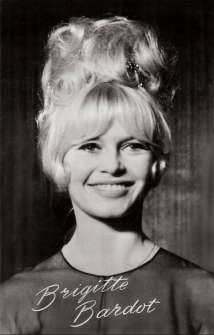
Brigitte Bardot
Dutch postcard by Uitgeverij Takken, Utrecht, no. AX 5204.Beautiful French actress Brigitte Bardot (1934) was the sex kitten of the European film industry. BB starred in 48 films, performed in numerous musical shows, and recorded 80 songs. After her retirement in 1973, she established herself as an animal rights activist and made vegetarianism sexy.Brigitte Bardot was born in Paris in 1934. Her father, Louis Bardot, had an engineering degree and worked with his father in the family business. Her mother, Ann-Marie Mucel, was 14 years younger than Brigitte's father and they married in 1933. Brigitte's mother encouraged her daughter to take up music and dance. At the age of 13, she entered the Conservatoire Nationale de Danse to study ballet. By the time she was 15, Brigitte was trying a modeling career and found herself in May 1949 on the cover of French magazine Elle. Her incredible beauty readily apparent, Brigitte was noticed by Roger Vadim, then an assistant to the film director Marc Allegrét. Vadim was infatuated with Bardot and encouraged her to start working as a film actress. BB was 18 when she debuted in the comedy Le Trou Normand/Crazy for Love (Jean Boyer, 1952). In the same year, she married Vadim. Brigitte wanted to marry him when she was 17, but her parents quashed any marriage plans until she turned 18. In April 1953 she attended the Cannes Film Festival where she received massive media attention. She soon was every man's idea of the girl he'd like to meet in Paris. From 1952 to 1956 she appeared in seventeen films. Her films were generally lightweight romantic dramas in which she was cast as ingénue or siren, often with an element of undress. She made her first US production in 1953 in Un acte d'amour/Act of Love (Anatole Litvak, 1953) with Kirk Douglas, but she continued to make films in France.Roger Vadim was not content with the light fare his wife was offered. He felt Brigitte Bardot was being undersold. Looking for something more like an art film to push her as a serious actress, he showcased her in Et Dieu créa la femme/...And God Created Woman (Roger Vadim, 1956). This film, about an immoral teenager in a respectable small-town setting, was a smashing success on both sides of the Atlantic. Craig Butler at AllMovie: "It's easy enough to say that ...And God Created Woman is much more important for its historical significance than for its actual quality as a film, and that's true to an extent. Woman's immense popularity, due to its willingness to directly embrace an exploration of sex as well as its willingness to show a degree of nudity that was remarkably daring for its day, demonstrated that audiences were willing to view subject matter that was considered too racy for the average moviegoer. This had both positive (freedom to explore, especially for the French filmmakers of the time) and negative (freedom to exploit) consequences, but its impact is undeniable. It's also true that Woman is not a great work of art, not with a story that is ultimately rather thin, some painful dialogue, and an attitude toward its characters and their sexuality that is unclear and inconsistent. Yet Woman is still fascinating, due in no small part to the presence of Brigitte Bardot in the role that made her an international star and sex symbol. She's not demonstrating great acting here, although her performance is actually good and much better than necessary, and her legendary mambo scene at the climax is nothing short of sensational." During the shooting of Et Dieu créa la femme/And God Created Woman (1956), directed by her husband Roger Vadim, Brigitte Bardot had an affair with her co-star Jean-Louis Trintignant, who at that time was married to French actress Stéphane Audran. Her divorce from Vadim followed, but they remained friends and collaborated in later work.Et Dieu créa la femme/...And God Created Woman (Roger Vadim, 1956) helped her international status. The film took the USA by storm, her explosive sexuality being unlike anything seen in the States since the days of the 'flapper' in the 1920s. It gave rise to the phrase 'sex kitten' and fascination of her in America consisted of magazines photographs and dubbed over French films - good, bad, or indifferent, her films drew audiences - mainly men - into theaters like lemmings.BB appeared in light comedies like Doctor at Large (1957) - the third of the British 'Doctor' series starring Dirk Bogarde - and Une Parisienne/La Parisienne (Michel Boisrond, 1957) which suited her acting skills best. However, she was a sensation in the crime drama En cas de malheur/Love is my profession (Claude Autant-Lara, 1958). Hal Erickson at AllMovie: "this Brigitte Bardot vehicle ran into stiff opposition from the Catholic Legion of Decency, severely limiting its U.S. distribution. Bardot plays a nubile small-time thief named Yvette, who becomes the mistress of influential defense attorney Andre (Jean Gabin). Though Andre is able to shower Yvette with jewels and furs, he cannot "buy" her heart, and thus it is that it belongs to handsome young student Mazzetti (Franco Interlenghi). Alas, Yvette is no judge of human nature: attractive though Mazzetti can be, he has a dangerous-and deadly-side. En Cas de Malheur contains a nude scene that has since been reprinted in freeze-frame form innumerable times by both film-history books and girlie magazines." Photographer Sam Lévin's photos contributed considerably to her image of sensuality and slight immorality. One of Lévin's pictures shows Brigitte, dressed in a white corset. It is said that around 1960 postcards with this photograph outsold in Paris those of the Eiffel Tower.Brigitte Bardot divorced Vadim in 1957 and in 1959 she married actor Jacques Charrier, with whom she starred in Babette s'en va-t-en guerre/Babette Goes to War (Christian-Jaque, 1959). The paparazzi preyed upon her marriage, while she and her husband clashed over the direction of her career. Her films became more substantial, but this brought a heavy pressure of dual celebrity as she sought critical acclaim while remaining a glamour model for most of the world. Vie privée/Private Life (1962), directed by Louis Malle has more than an element of autobiography in it. James Travers at Films de France: "Brigitte Bardot hadn’t quite reached the highpoint of her career when she agreed to make this film with high profile New Wave film director Louis Malle. Even so, the pressure of being a living icon was obviously beginning to get to France’s sex goddess and Vie privée is as much an attempt by Bardot to come to terms with her celebrity as anything else. Malle is clearly fascinated by Bardot and the documentary approach he adopts for this film reinforces the impression that it is more a biography of the actress than a work of fiction. Of course, it’s not entirely biographical, but the story is remarkably close to Bardot’s own life and comes pretty close to predicting how her career would end." The scene in which, returning to her apartment, Bardot's character is harangued in the elevator by a middle-aged cleaning lady calling her offensive names, was based on an actual incident and is a resonant image of a celebrity in the mid-20th century. Soon afterward Bardot withdrew to the seclusion of Southern France.Brigitte Bardot's other husbands were German millionaire playboy Gunter Sachs and right-wing politician Bernard d'Ormale. She is reputed to have had relationships with many other men including Sami Frey, her co-star in La Vérité/The Truth (Henri-Georges Clouzot, 1960), and musicians Serge Gainsbourg and Sacha Distel. In 1963, Brigitte Bardot starred in Godard's critically acclaimed film Le Mépris/Contempt (Jean-Luc Godard, 1963). She was also featured along with such notable actors as Alain Delon in Amours célèbres/Famous Love Affairs (Michel Boisrond, 1961) and Histoires extraordinaires/Tales of Mystery (Louis Malle, 1968), Jeanne Moreau in Viva Maria! (Louis Malle, 1965), Sean Connery in Shalako (Edward Dmytryk, 1968), and Claudia Cardinale in Les Pétroleuses/Petroleum Girls (Christian-Jaque, 1971). She participated in various musical shows and recorded many popular songs in the 1960s and 1970s, mostly in collaboration with Serge Gainsbourg, Bob Zagury and Sacha Distel, including 'Harley Davidson', 'Le Soleil De Ma Vie' (the cover of Stevie Wonder's 'You Are the Sunshine of My Life') and the notorious 'Je t'aime... moi non plus'.Brigitte Bardot’s film career showed a steady decline in the late 1960s and early 1970s. In 1973 just before her fortieth birthday, she announced her retirement. She chose to use her fame to promote animal rights. In 1976 she established the Brigitte Bardot Foundation for the Welfare and Protection of Animals. She became a vegetarian and raised three million French francs to fund the foundation by auctioning off jewelry and many personal belongings. For this work, she was awarded the Légion d’honneur in 1984. During the 1990's she became also outspoken in her criticism of immigration, interracial relationships, Islam in France and homosexuality. Her husband Bernard d'Ormal is a former adviser of the far-right Front National party. Bardot has been convicted five times for 'inciting racial hatred'. More fun is that Bardot is recognised for popularizing bikini swimwear, in early films such as Manina/Woman without a Veil (1952), in her appearances at Cannes and in many photoshoots. Bardot also brought into fashion the 'choucroute' ('Sauerkraut') hairstyle (a sort of beehive hairstyle) and gingham clothes after wearing a checkered pink dress, designed by Jacques Esterel, at her wedding to Charrier. The fashions of the 1960s looked effortlessly right and spontaneous on her. Time Magazine: "She is the princess of pout, the countess of come hither. Brigitte Bardot exuded a carefree, naïve sexuality that brought a whole new audience to French films."Sources: Denny Jackson (IMDb), Hal Erickson (AllMovie), Craig Butler (AllMovie), James Travers (Films de France), Films de France, Wikipedia, and IMDb.And, please check out our blog European Film Star Postcards.
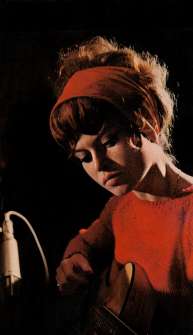
Brigitte Bardot
French postcard by Publistar, offered by Corvisart, Epinal, no. 889. Photo: Wiezniak / Philips.Beautiful French actress Brigitte Bardot (1934) was the sex kitten of the European film industry. BB starred in 48 films, performed in numerous musical shows, and recorded 80 songs. After her retirement in 1973, she established herself as an animal rights activist and made vegetarianism sexy.Brigitte Bardot was born in Paris in 1934. Her father, Louis Bardot, had an engineering degree and worked with his father in the family business. Her mother, Ann-Marie Mucel, was 14 years younger than Brigitte's father and they married in 1933. Brigitte's mother encouraged her daughter to take up music and dance. At the age of 13, she entered the Conservatoire Nationale de Danse to study ballet. By the time she was 15, Brigitte was trying a modeling career and found herself in May 1949 on the cover of French magazine Elle. Her incredible beauty readily apparent, Brigitte was noticed by Roger Vadim, then an assistant to the film director Marc Allegrét. Vadim was infatuated with Bardot and encouraged her to start working as a film actress. BB was 18 when she debuted in the comedy Le Trou Normand/Crazy for Love (Jean Boyer, 1952). In the same year, she married Vadim. Brigitte wanted to marry him when she was 17, but her parents quashed any marriage plans until she turned 18. In April 1953 she attended the Cannes Film Festival where she received massive media attention. She soon was every man's idea of the girl he'd like to meet in Paris. From 1952 to 1956 she appeared in seventeen films. Her films were generally lightweight romantic dramas in which she was cast as ingénue or siren, often with an element of undress. She made her first US production in 1953 in Un acte d'amour/Act of Love (Anatole Litvak, 1953) with Kirk Douglas, but she continued to make films in France.Roger Vadim was not content with the light fare his wife was offered. He felt Brigitte Bardot was being undersold. Looking for something more like an art film to push her as a serious actress, he showcased her in Et Dieu créa la femme/...And God Created Woman (Roger Vadim, 1956). This film, about an immoral teenager in a respectable small-town setting, was a smashing success on both sides of the Atlantic. Craig Butler at AllMovie: "It's easy enough to say that ...And God Created Woman is much more important for its historical significance than for its actual quality as a film, and that's true to an extent. Woman's immense popularity, due to its willingness to directly embrace an exploration of sex as well as its willingness to show a degree of nudity that was remarkably daring for its day, demonstrated that audiences were willing to view subject matter that was considered too racy for the average moviegoer. This had both positive (freedom to explore, especially for the French filmmakers of the time) and negative (freedom to exploit) consequences, but its impact is undeniable. It's also true that Woman is not a great work of art, not with a story that is ultimately rather thin, some painful dialogue, and an attitude toward its characters and their sexuality that is unclear and inconsistent. Yet Woman is still fascinating, due in no small part to the presence of Brigitte Bardot in the role that made her an international star and sex symbol. She's not demonstrating great acting here, although her performance is actually good and much better than necessary, and her legendary mambo scene at the climax is nothing short of sensational." During the shooting of Et Dieu créa la femme/And God Created Woman (1956), directed by her husband Roger Vadim, Brigitte Bardot had an affair with her co-star Jean-Louis Trintignant, who at that time was married to French actress Stéphane Audran. Her divorce from Vadim followed, but they remained friends and collaborated in later work.Et Dieu créa la femme/...And God Created Woman (Roger Vadim, 1956) helped her international status. The film took the USA by storm, her explosive sexuality being unlike anything seen in the States since the days of the 'flapper' in the 1920s. It gave rise to the phrase 'sex kitten' and fascination of her in America consisted of magazines photographs and dubbed over French films - good, bad, or indifferent, her films drew audiences - mainly men - into theaters like lemmings.BB appeared in light comedies like Doctor at Large (1957) - the third of the British 'Doctor' series starring Dirk Bogarde - and Une Parisienne/La Parisienne (Michel Boisrond, 1957) which suited her acting skills best. However, she was a sensation in the crime drama En cas de malheur/Love is my profession (Claude Autant-Lara, 1958). Hal Erickson at AllMovie: "this Brigitte Bardot vehicle ran into stiff opposition from the Catholic Legion of Decency, severely limiting its U.S. distribution. Bardot plays a nubile small-time thief named Yvette, who becomes the mistress of influential defense attorney Andre (Jean Gabin). Though Andre is able to shower Yvette with jewels and furs, he cannot "buy" her heart, and thus it is that it belongs to handsome young student Mazzetti (Franco Interlenghi). Alas, Yvette is no judge of human nature: attractive though Mazzetti can be, he has a dangerous-and deadly-side. En Cas de Malheur contains a nude scene that has since been reprinted in freeze-frame form innumerable times by both film-history books and girlie magazines." Photographer Sam Lévin's photos contributed considerably to her image of sensuality and slight immorality. One of Lévin's pictures shows Brigitte, dressed in a white corset. It is said that around 1960 postcards with this photograph outsold in Paris those of the Eiffel Tower.Brigitte Bardot divorced Vadim in 1957 and in 1959 she married actor Jacques Charrier, with whom she starred in Babette s'en va-t-en guerre/Babette Goes to War (Christian-Jaque, 1959). The paparazzi preyed upon her marriage, while she and her husband clashed over the direction of her career. Her films became more substantial, but this brought a heavy pressure of dual celebrity as she sought critical acclaim while remaining a glamour model for most of the world. Vie privée/Private Life (1962), directed by Louis Malle has more than an element of autobiography in it. James Travers at Films de France: "Brigitte Bardot hadn’t quite reached the highpoint of her career when she agreed to make this film with high profile New Wave film director Louis Malle. Even so, the pressure of being a living icon was obviously beginning to get to France’s sex goddess and Vie privée is as much an attempt by Bardot to come to terms with her celebrity as anything else. Malle is clearly fascinated by Bardot and the documentary approach he adopts for this film reinforces the impression that it is more a biography of the actress than a work of fiction. Of course, it’s not entirely biographical, but the story is remarkably close to Bardot’s own life and comes pretty close to predicting how her career would end." The scene in which, returning to her apartment, Bardot's character is harangued in the elevator by a middle-aged cleaning lady calling her offensive names, was based on an actual incident and is a resonant image of celebrity in the mid-20th century. Soon afterward Bardot withdrew to the seclusion of Southern France.Brigitte Bardot's other husbands were German millionaire playboy Gunter Sachs and right-wing politician Bernard d'Ormale. She is reputed to have had relationships with many other men including Sami Frey, her co-star in La Vérité/The Truth (Henri-Georges Clouzot, 1960), and musicians Serge Gainsbourg and Sacha Distel. In 1963, Brigitte Bardot starred in Godard's critically acclaimed film Le Mépris/Contempt (Jean-Luc Godard, 1963). She was also featured along with such notable actors as Alain Delon in Amours célèbres/Famous Love Affairs (Michel Boisrond, 1961) and Histoires extraordinaires/Tales of Mystery (Louis Malle, 1968), Jeanne Moreau in Viva Maria! (Louis Malle, 1965), Sean Connery in Shalako (Edward Dmytryk, 1968), and Claudia Cardinale in Les Pétroleuses/Petroleum Girls (Christian-Jaque, 1971). She participated in various musical shows and recorded many popular songs in the 1960s and 1970s, mostly in collaboration with Serge Gainsbourg, Bob Zagury and Sacha Distel, including 'Harley Davidson', 'Le Soleil De Ma Vie' (the cover of Stevie Wonder's 'You Are the Sunshine of My Life') and the notorious 'Je t'aime... moi non plus'.Brigitte Bardot’s film career showed a steady decline in the late 1960s and early 1970s. In 1973 just before her fortieth birthday, she announced her retirement. She chose to use her fame to promote animal rights. In 1976 she established the Brigitte Bardot Foundation for the Welfare and Protection of Animals. She became a vegetarian and raised three million French francs to fund the foundation by auctioning off jewelry and many personal belongings. For this work, she was awarded the Légion d’honneur in 1984. During the 1990's she became also outspoken in her criticism of immigration, interracial relationships, Islam in France and homosexuality. Her husband Bernard d'Ormal is a former adviser of the far-right Front National party. Bardot has been convicted five times for 'inciting racial hatred'. More fun is that Bardot is recognised for popularizing bikini swimwear, in early films such as Manina/Woman without a Veil (1952), in her appearances at Cannes and in many photoshoots. Bardot also brought into fashion the choucroute ('Sauerkraut') hairstyle (a sort of beehive hairstyle) and gingham clothes after wearing a checkered pink dress, designed by Jacques Esterel, at her wedding to Charrier. The fashions of the 1960s looked effortlessly right and spontaneous on her. Time Magazine: "She is the princess of pout, the countess of come hither. Brigitte Bardot exuded a carefree, naïve sexuality that brought a whole new audience to French films."Sources: Denny Jackson (IMDb), Hal Erickson (AllMovie), Craig Butler (AllMovie), James Travers (Films de France), Films de France, Wikipedia, and IMDb.And, please check out our blog European Film Star Postcards.
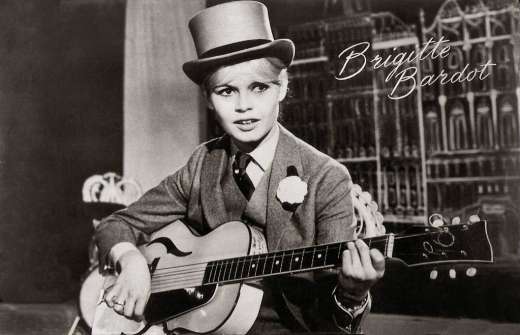
Brigitte Bardot in Happy New Year Brigitte (1961)
Dutch postcard by Uitgeverij Takken, Utrecht, no. AX 4903. Photo: Dalmas. Brigitte Bardot plays the guitar in the TV show Happy New Year Brigitte, which aired on the evening of 31 December 1961.Beautiful French actress Brigitte Bardot (1934) was the sex kitten of the European film industry. BB starred in 48 films, performed in numerous musical shows, and recorded 80 songs. After her retirement in 1973, she established herself as an animal rights activist and made vegetarianism sexy.Brigitte Bardot was born in Paris in 1934. Her father, Louis Bardot, had an engineering degree and worked with his father in the family business. Her mother, Ann-Marie Mucel, was 14 years younger than Brigitte's father and they married in 1933. Brigitte's mother encouraged her daughter to take up music and dance. At the age of 13, she entered the Conservatoire Nationale de Danse to study ballet. By the time she was 15, Brigitte was trying a modeling career and found herself in May 1949 on the cover of French magazine Elle. Her incredible beauty readily apparent, Brigitte was noticed by Roger Vadim, then an assistant to the film director Marc Allegrét. Vadim was infatuated with Bardot and encouraged her to start working as a film actress. BB was 18 when she debuted in the comedy Le Trou Normand/Crazy for Love (Jean Boyer, 1952). In the same year, she married Vadim. Brigitte wanted to marry him when she was 17, but her parents quashed any marriage plans until she turned 18. In April 1953 she attended the Cannes Film Festival where she received massive media attention. She soon was every man's idea of the girl he'd like to meet in Paris. From 1952 to 1956 she appeared in seventeen films. Her films were generally lightweight romantic dramas in which she was cast as ingénue or siren, often with an element of undress. She made her first US production in 1953 in Un acte d'amour/Act of Love (Anatole Litvak, 1953) with Kirk Douglas, but she continued to make films in France.Roger Vadim was not content with the light fare his wife was offered. He felt Brigitte Bardot was being undersold. Looking for something more like an art film to push her as a serious actress, he showcased her in Et Dieu créa la femme/...And God Created Woman (Roger Vadim, 1956). This film, about an immoral teenager in a respectable small-town setting, was a smashing success on both sides of the Atlantic. Craig Butler at AllMovie: "It's easy enough to say that ...And God Created Woman is much more important for its historical significance than for its actual quality as a film, and that's true to an extent. Woman's immense popularity, due to its willingness to directly embrace an exploration of sex as well as its willingness to show a degree of nudity that was remarkably daring for its day, demonstrated that audiences were willing to view subject matter that was considered too racy for the average moviegoer. This had both positive (freedom to explore, especially for the French filmmakers of the time) and negative (freedom to exploit) consequences, but its impact is undeniable. It's also true that Woman is not a great work of art, not with a story that is ultimately rather thin, some painful dialogue, and an attitude toward its characters and their sexuality that is unclear and inconsistent. Yet Woman is still fascinating, due in no small part to the presence of Brigitte Bardot in the role that made her an international star and sex symbol. She's not demonstrating great acting here, although her performance is actually good and much better than necessary, and her legendary mambo scene at the climax is nothing short of sensational." During the shooting of Et Dieu créa la femme/And God Created Woman (1956), directed by her husband Roger Vadim, Brigitte Bardot had an affair with her co-star Jean-Louis Trintignant, who at that time was married to French actress Stéphane Audran. Her divorce from Vadim followed, but they remained friends and collaborated in later work.Et Dieu créa la femme/...And God Created Woman (Roger Vadim, 1956) helped her international status. The film took the USA by storm, her explosive sexuality being unlike anything seen in the States since the days of the 'flapper' in the 1920s. It gave rise to the phrase 'sex kitten' and fascination of her in America consisted of magazines photographs and dubbed over French films - good, bad, or indifferent, her films drew audiences - mainly men - into theaters like lemmings.BB appeared in light comedies like Doctor at Large (1957) - the third of the British 'Doctor' series starring Dirk Bogarde - and Une Parisienne/La Parisienne (Michel Boisrond, 1957) which suited her acting skills best. However, she was a sensation in the crime drama En cas de malheur/Love is my profession (Claude Autant-Lara, 1958). Hal Erickson at AllMovie: "this Brigitte Bardot vehicle ran into stiff opposition from the Catholic Legion of Decency, severely limiting its U.S. distribution. Bardot plays a nubile small-time thief named Yvette, who becomes the mistress of influential defense attorney Andre (Jean Gabin). Though Andre is able to shower Yvette with jewels and furs, he cannot "buy" her heart, and thus it is that it belongs to handsome young student Mazzetti (Franco Interlenghi). Alas, Yvette is no judge of human nature: attractive though Mazzetti can be, he has a dangerous-and deadly-side. En Cas de Malheur contains a nude scene that has since been reprinted in freeze-frame form innumerable times by both film-history books and girlie magazines." Photographer Sam Lévin's photos contributed considerably to her image of sensuality and slight immorality. One of Lévin's pictures shows Brigitte, dressed in a white corset. It is said that around 1960 postcards with this photograph outsold in Paris those of the Eiffel Tower.Brigitte Bardot divorced Vadim in 1957 and in 1959 she married actor Jacques Charrier, with whom she starred in Babette s'en va-t-en guerre/Babette Goes to War (Christian-Jaque, 1959). The paparazzi preyed upon her marriage, while she and her husband clashed over the direction of her career. Her films became more substantial, but this brought a heavy pressure of dual celebrity as she sought critical acclaim while remaining a glamour model for most of the world. Vie privée/Private Life (1962), directed by Louis Malle has more than an element of autobiography in it. James Travers at Films de France: "Brigitte Bardot hadn’t quite reached the highpoint of her career when she agreed to make this film with high profile New Wave film director Louis Malle. Even so, the pressure of being a living icon was obviously beginning to get to France’s sex goddess and Vie privée is as much an attempt by Bardot to come to terms with her celebrity as anything else. Malle is clearly fascinated by Bardot and the documentary approach he adopts for this film reinforces the impression that it is more a biography of the actress than a work of fiction. Of course, it’s not entirely biographical, but the story is remarkably close to Bardot’s own life and comes pretty close to predicting how her career would end." The scene in which, returning to her apartment, Bardot's character is harangued in the elevator by a middle-aged cleaning lady calling her offensive names, was based on an actual incident and is a resonant image of celebrity in the mid-20th century. Soon afterward Bardot withdrew to the seclusion of Southern France.Brigitte Bardot's other husbands were German millionaire playboy Gunter Sachs and right-wing politician Bernard d'Ormale. She is reputed to have had relationships with many other men including Sami Frey, her co-star in La Vérité/The Truth (Henri-Georges Clouzot, 1960), and musicians Serge Gainsbourg and Sacha Distel. In 1963, Brigitte Bardot starred in Godard's critically acclaimed film Le Mépris/Contempt (Jean-Luc Godard, 1963). She was also featured along with such notable actors as Alain Delon in Amours célèbres/Famous Love Affairs (Michel Boisrond, 1961) and Histoires extraordinaires/Tales of Mystery (Louis Malle, 1968), Jeanne Moreau in Viva Maria! (Louis Malle, 1965), Sean Connery in Shalako (Edward Dmytryk, 1968), and Claudia Cardinale in Les Pétroleuses/Petroleum Girls (Christian-Jaque, 1971). She participated in various musical shows and recorded many popular songs in the 1960s and 1970s, mostly in collaboration with Serge Gainsbourg, Bob Zagury and Sacha Distel, including 'Harley Davidson', 'Le Soleil De Ma Vie' (the cover of Stevie Wonder's 'You Are the Sunshine of My Life') and the notorious 'Je t'aime... moi non plus'.Brigitte Bardot’s film career showed a steady decline in the late 1960s and early 1970s. In 1973 just before her fortieth birthday, she announced her retirement. She chose to use her fame to promote animal rights. In 1976 she established the Brigitte Bardot Foundation for the Welfare and Protection of Animals. She became a vegetarian and raised three million French francs to fund the foundation by auctioning off jewelry and many personal belongings. For this work, she was awarded the Légion d’honneur in 1984. During the 1990's she became also outspoken in her criticism of immigration, interracial relationships, Islam in France and homosexuality. Her husband Bernard d'Ormal is a former adviser of the far-right Front National party. Bardot has been convicted five times for 'inciting racial hatred'. More fun is that Bardot is recognised for popularizing bikini swimwear, in early films such as Manina/Woman without a Veil (1952), in her appearances at Cannes and in many photoshoots. Bardot also brought into fashion the choucroute ('Sauerkraut') hairstyle (a sort of beehive hairstyle) and gingham clothes after wearing a checkered pink dress, designed by Jacques Esterel, at her wedding to Charrier. The fashions of the 1960s looked effortlessly right and spontaneous on her. Time Magazine: "She is the princess of pout, the countess of come hither. Brigitte Bardot exuded a carefree, naïve sexuality that brought a whole new audience to French films."Sources: Denny Jackson (IMDb), Hal Erickson (AllMovie), Craig Butler (AllMovie), James Travers (Films de France), Films de France, Wikipedia, and IMDb.And, please check out our blog European Film Star Postcards.
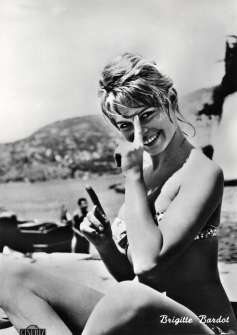
Brigitte Bardot
Italian postcard by Bromofoto, Milano, no. 1435. Photo: Cineriz.Beautiful French actress Brigitte Bardot (1934) was the sex kitten of the European film industry. BB starred in 48 films, performed in numerous musical shows, and recorded 80 songs. After her retirement in 1973, she established herself as an animal rights activist and made vegetarianism sexy.And please check out our blog European Film Star Postcards.
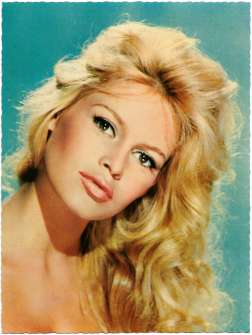
Brigitte Bardot
Big Dutch postcard, no. 606. Photo: Sam Lévin.Beautiful French actress Brigitte Bardot (1934) was the sex kitten of the European film industry. BB starred in 48 films, performed in numerous musical shows, and recorded 80 songs. After her retirement in 1973, she established herself as an animal rights activist and made vegetarianism sexy.And please check out our blog European Film Star Postcards.
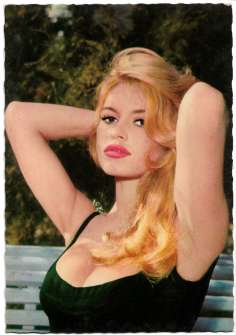
Brigitte Bardot
German postcard by ISV, no. H 71. Photo: Sam Lévin.Beautiful French actress Brigitte Bardot (1934) was the sex kitten of the European film industry. BB starred in 48 films, performed in numerous musical shows, and recorded 80 songs. After her retirement in 1973, she established herself as an animal rights activist and made vegetarianism sexy.And please check out our blog European Film Star Postcards.

French actress Brigitte Bardot on the set of 'Les Petroleuses' a.k.a. 'The Legend of Frenchie King', directed by Christian-Jaque in Spain, 1971.
Photographed by Terry O'Neill (1938-2019) R.I.P.
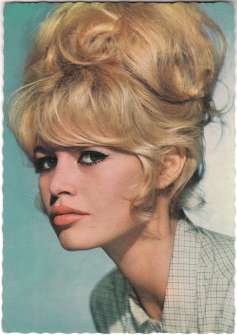
Brigitte Bardot
Scanned by me - CP E.D.U.G. d'après photo Sam Levin
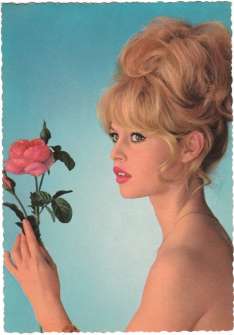
Brigitte Bardot
PC Krüger 902/350 Photo Sam Lévin. Scanned by me. J'aime cette carte pour ses couleurs, parfaitement en accord, et pour la rose, la plus belle de toutes les fleurs, la fleur des fleurs (comme la Bible est le livre des livres). Cette rose rajoute à l'impression de "carte postale florale". Brigitte a beau être une "bonne actrice", elle est aussi un instrument pour la réalisation de quelques jolies cartes.
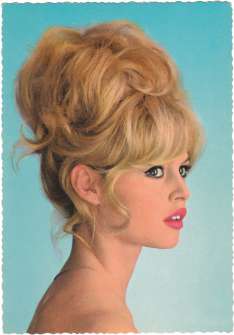
Brigitte Bardot
Postcard by Krüger 902 354 Photo Sam Lévin. Scanned by me
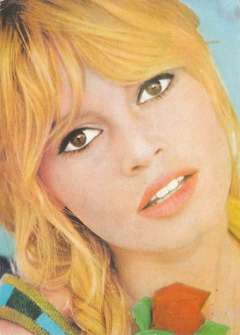
Brigitte Bardot
Scanned by me. Postcard by CASA FILMULUI ACIN, C.P.C.S., c-da 53065.
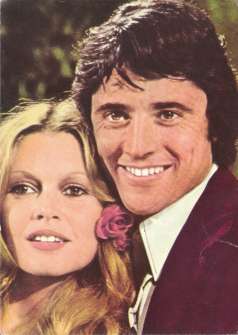
Brigitte Bardot, Sacha Distel
Scanned by me. Postcard by CASA FILMULUI ACIN (562).

Romina Power, Brigitte Bardot, Vanessa Redgrave
Ciné Revue 1967
Scanned by me
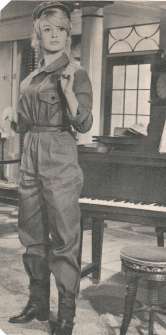
Brigitte Bardot
Scanned by me
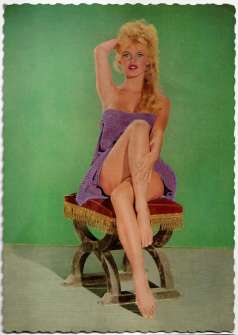
Brigitte Bardot
German postcard by UFA, Berlin-Tempelhof, no. CK 380. Photo: Sam Lévin / UFA.Beautiful French actress Brigitte Bardot (1934) was the sex kitten of the European film industry. BB starred in 48 films, performed in numerous musical shows, and recorded 80 songs. After her retirement in 1973, she established herself as an animal rights activist and made vegetarianism sexy.And please check out our blog European Film Star Postcards.
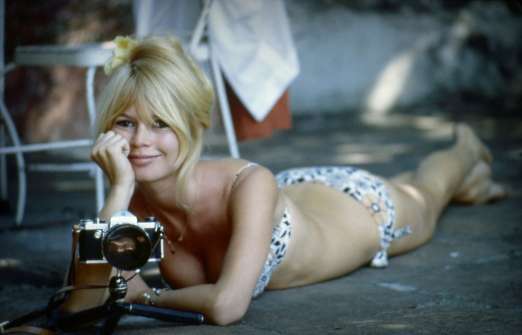
Brigitte Bardot. 1960s.
48888991068_8f5bff7483_b

Brigitte Bardot. 1960s.
48889526821_72634d3de6_b
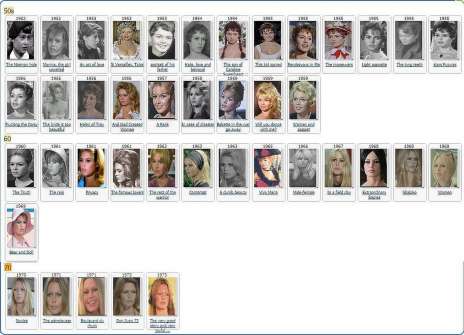
Brigitte Bardot's films in pictures.
Note that most of the names are literal translations of the original titles, and not as they were renamed for foreign markets (ie UK, USA, etc.).
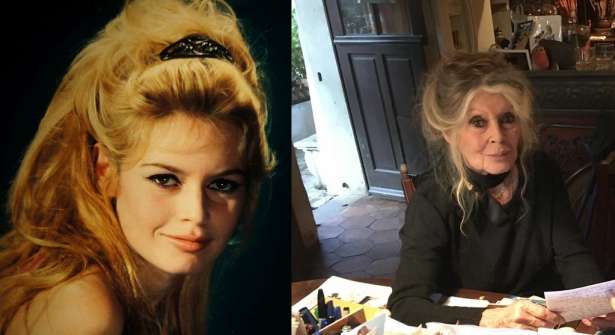
Happy 85th Birthday, Brigitte Bardot. (Born 28 September 1934).
In the 1960s and in 2018.
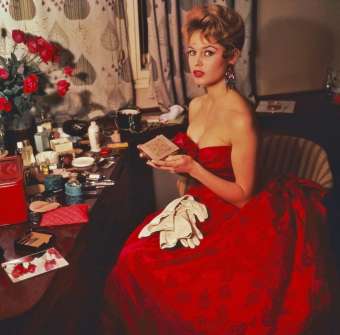
Happy 85th Birthday, Brigitte Bardot. (Born 28 September 1934).
48805463002_27e575266e_b

Brigitte Bardot.
48704998843_c6d477eb40_b
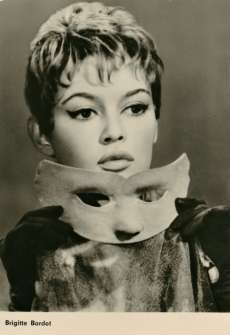
Brigitte Bardot c 1963 Old Post
48247372337_3a0da6ca83_b

BB?
View Large.
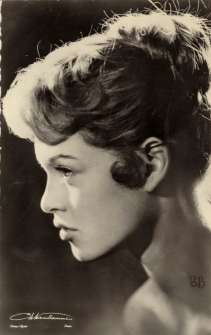
Brigitte Bardot c 1956 Old Post
48116811907_ab0fb4782e_b
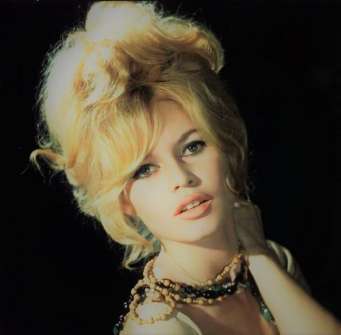
Brigitte Bardot by Sam Levin, 1963
48152043597_4e3c390279_z
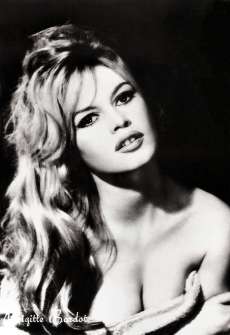
Brigitte Bardot
Yugoslavian postcard by NPO, no. G18. Photo: Sam Lévin.Beautiful French actress Brigitte Bardot (1934) was the sex kitten of the European film industry. BB starred in 48 films, performed in numerous musical shows, and recorded 80 songs. After her retirement in 1973, she established herself as an animal rights activist and made vegetarianism sexy.And please check out our blog European Film Star Postcards.
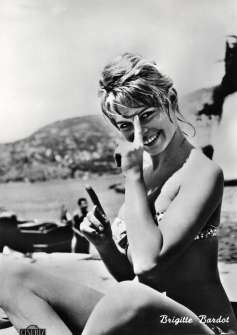
Brigitte Bardot
Italian postcard by Bromofoto, Milano, no. 1435. Photo: Cineriz.Beautiful French actress Brigitte Bardot (1934) was the sex kitten of the European film industry. BB starred in 48 films, performed in numerous musical shows, and recorded 80 songs. After her retirement in 1973, she established herself as an animal rights activist and made vegetarianism sexy.For more postcards, a bio and clips check out our blog European Film Star Postcards.
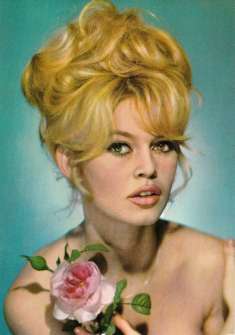
Brigitte Bardot
French postcard by Editions P.I., Paris, no. 1121. Photo: Sam Lévin.Beautiful French actress Brigitte Bardot (1934) was the sex kitten of the European film industry. BB starred in 48 films, performed in numerous musical shows, and recorded 80 songs. After her retirement in 1973, she established herself as an animal rights activist and made vegetarianism sexy.For more postcards, a bio and clips check out our blog European Film Star Postcards.
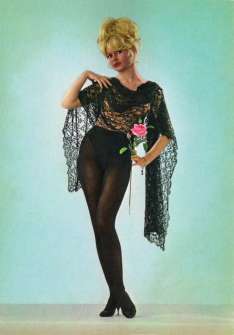
Brigitte Bardot
French postcard by Editions P.I., Paris, no. 1133. Photo: Sam Lévin.Beautiful French actress Brigitte Bardot (1934) was the sex kitten of the European film industry. BB starred in 48 films, performed in numerous musical shows, and recorded 80 songs. After her retirement in 1973, she established herself as an animal rights activist and made vegetarianism sexy.For more postcards, a bio and clips check out our blog European Film Star Postcards.
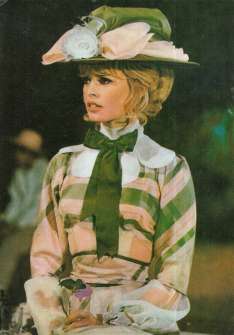
Brigitte Bardot
CASA FILMULUI ACIN (515)
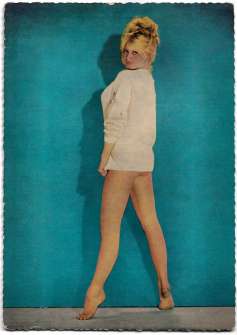
Brigitte Bardot
Belgian postcard by S. Best, Antwerp. Photo: Sam Lévin.Beautiful French actress Brigitte Bardot (1934) was the sex kitten of the European film industry. BB starred in 48 films, performed in numerous musical shows, and recorded 80 songs. After her retirement in 1973, she established herself as an animal rights activist and made vegetarianism sexy.For more postcards, a bio and clips check out our blog European Film Star Postcards.
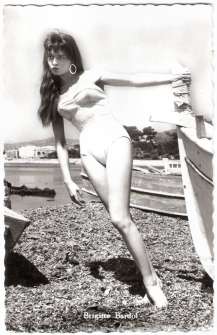
Brigitte Bardot
Dutch postcard.Beautiful French actress Brigitte Bardot (1934) was the sex kitten of the European film industry. BB starred in 48 films, performed in numerous musical shows, and recorded 80 songs. After her retirement in 1973, she established herself as an animal rights activist and made vegetarianism sexy.For more postcards, a bio and clips check out our blog European Film Star Postcards.
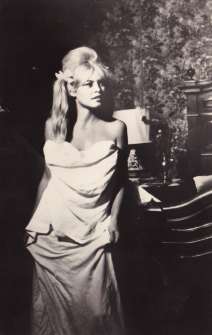
Brigitte Bardot in Vie Privée (1962)
Czech postcard by Pressfoto, Praha (Prague). Photo: publicity still for Vie privée/A Very Private Affair (Louis Malle, 1962). Collection: Carla Bosch.Carla: And now Brigitte Bardotova in ”Soukromy Zivot” or “Vie Privée”, released in 1961. Brigitte Bardot plays a girl who lives in Switzerland with her widowed mother. She is infatuated with Marcello Mastroianni who is married to a friend of hers, unfortunately. There is some unclarity on the different sites that discuss this movie. Some say Marcello is married to her friend, others say he is her mother’s ex-lover. Perhaps he is both. Anyway, Brigitte has had it in Switzerland and moves to Paris where she becomes a famous movie star and model. She experiences the negative aspects of such a career: she does not have a private life and is regarded as public property. She returns to Switzerland where she finds Marcello divorced, fortunately. They start an affair, but the fans and papparazzi claim her again. She trusts Marcello to protect her from the intrusive press that hounds her. But Marcello, a film director himself, seems more interested in a play he is directing. Brigitte becomes depressed and withdraws from public life. It could have been the story of Brigitte Bardo herself, the actress and model! Brigitte was 28 when she played the leading role in “A Very Private Affair”, but she apparently had great foresight. The film was not a great success. Yet, rather interesting as we look at it through new eyes perhaps? I don’t know what to make of the postcard. We see Brigitte wrapped in a bed sheet. The bed is behind her. She looks lovely in that sheet.
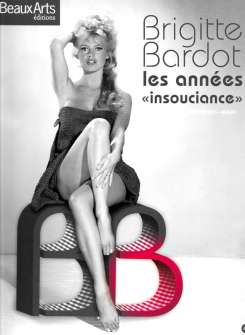
Exposition BB
3997640279_e550fbafd6_b
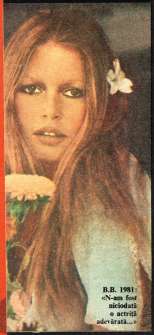
Brigitte Bardot
Scan. Cinema, nr. 4, anul XIX (220). Revistă a Consiliului Culturii şi Educaţiei Socialiste. București, aprilie 1981.
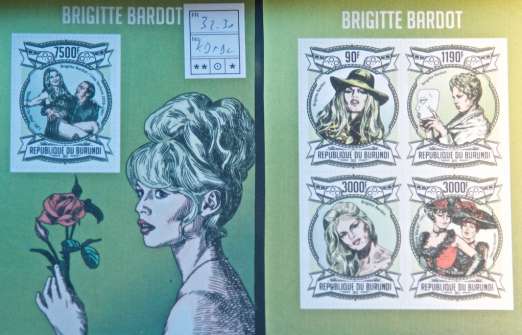
2018-07-03 SWITZERLAND Zurich 145 - Brigitte Bardot Stamps in Philatelei Walter Window on Oberdorfstrasse
Copyright (c) 2018. All rights reserved. May only be republished with permission by Lee B. Spitzer.
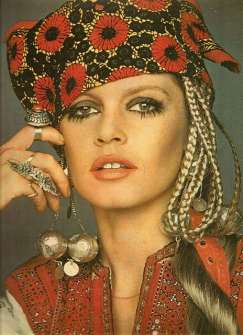
Brigitte Bardot
43460731881_69db91020c_z

Brigitte Bardot
We're near to hundred million (yes, eight zeros) views. So we invited BB to stir the views a bit, so we don't need to stay up all night for that milepole 🙂 French postcard by E.D.U.G., no. 5. Photo: Sam Lévin.Beautiful French actress Brigitte Bardot (1934) was the sex kitten of the European film industry. BB starred in 48 films, performed in numerous musical shows, and recorded 80 songs. After her retirement in 1973, she established herself as an animal rights activist and made vegetarianism sexy.For more postcards, a bio and clips check out our blog European Film Star Postcards.
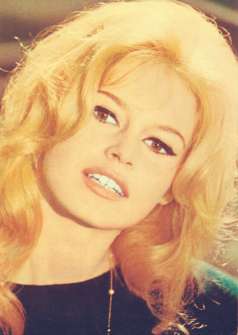
Brigitte Bardot
Scanned by me. Postcard by CASA FILMULUI ACIN.

Brigitte Bardot
French postcard by Editions P.I., Paris, offered by Les Carbones Korès, no. 464. Photo: Sam Lévin.During the 1950s and 1960s, Brigitte Bardot (1934) was the sex kitten of the European cinema and every man's idea of the girl he'd like to meet in Paris.And check her out at European Film Star Postcards.
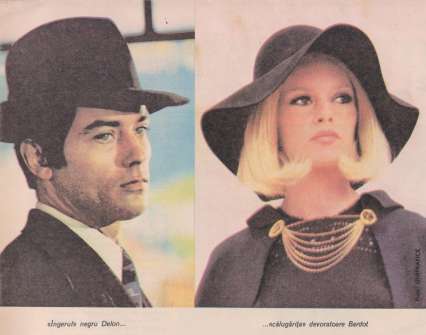
Alain Delon, Brigitte Bardot
Cinema, nr. 4, anul VIII (88). Revistă lunară de cultură cinematografică. București - aprilie - 1970.
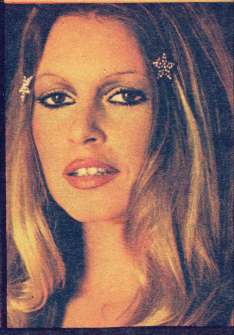
Anna Karina, Brigitte Bardot
Scan - Cinema Dec. 1985

Brigitte Bardot
Almanah Cinema 1970

Brigitte Bardot
French postcard by Editions du Globe, Paris, no. 338. Photo: Studio Harcourt.During the 1950s and 1960s, Brigitte Bardot (1934) was the sex kitten of the European cinema and every man's idea of the girl he'd like to meet in Paris.And check her out at European Film Star Postcards.
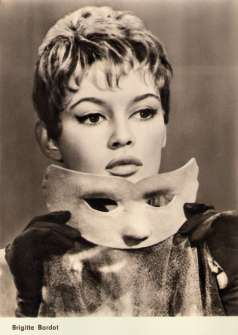
Brigitte Bardot in En effeuillant la marguerite (1956)
East-German postcard by VEB Progress Filmvertrieb, Berlin, no. 1.975, 1963. Photo: publicity still for En effeuillant la marguerite/Plucking the Daisy (Marc Allégret, 1956).Brigitte Bardot (1934) was the sex kitten of the European cinema. During the 1950s and 1960s, she was every man's idea of the girl he'd like to meet in Paris.For more postcards, a bio and clips check out our blog European Film Star Postcards, see our set And God Created B.B.
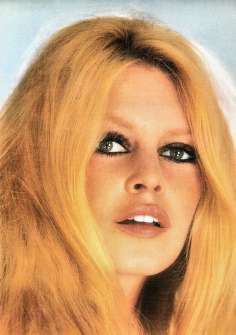
Brigitte Bardot
French postcard by E.D.U.G., no. 493. Photo: Sam Lévin.Beautiful French actress Brigitte Bardot (1934) was the sex kitten of the European film industry. BB starred in 48 films, performed in numerous musical shows, and recorded 80 songs. After her retirement in 1973, she established herself as an animal rights activist and made vegetarianism sexy.For more postcards, a bio and clips check out our blog European Film Star Postcards.
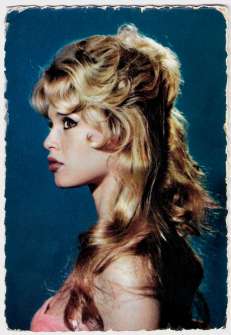
Brigitte Bardot
French postcard by Mexichrome, no. 1. Photo: Sam Lévin.Beautiful French actress Brigitte Bardot (1934) was the sex kitten of the European film industry. BB starred in 48 films, performed in numerous musical shows, and recorded 80 songs. After her retirement in 1973, she established herself as an animal rights activist and made vegetarianism sexy.For more postcards, a bio and clips check out our blog European Film Star Postcards.
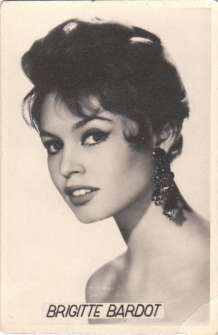
Brigitte Bardot
Scan -

Brigitte Bardot
Scan -
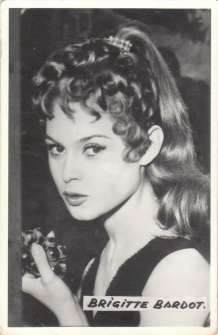
Brigitte Bardot
Scan -
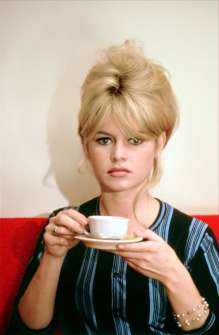
Le Mépris
Brigitte Bardot
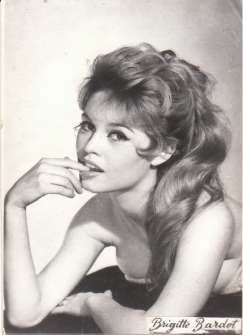
Brigitte Bardot
Scan -

Brigitte Bardot
Scanned by me
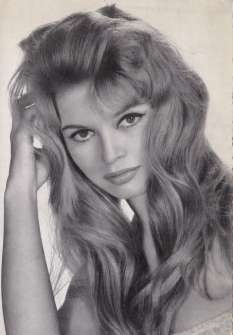
Brigitte Bardot
German postcard by WS-Druck Wanne-Eickel. Collection: Carla Bosch.Beautiful French actress Brigitte Bardot (1934) was the sex kitten of the European film industry. BB starred in 48 films, performed in numerous musical shows, and recorded 80 songs. After her retirement in 1973, she established herself as an animal rights activist and made vegetarianism sexy.For more postcards, a bio and clips check out our blog European Film Star Postcards. We've uploaded this postcard for a special In Memoriam at EFSP for collector Han de Gruiter on 21 October 2017.
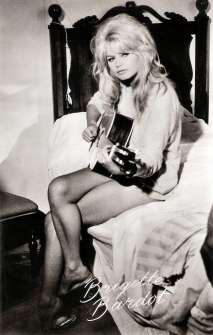
Brigitte Bardot
Dutch postcard by Uitgeverij Takken, Utrecht, no. AX 4791.Beautiful French actress Brigitte Bardot (1934) was the sex kitten of the European film industry. BB starred in 48 films, performed in numerous musical shows, and recorded 80 songs. After her retirement in 1973, she established herself as an animal rights activist and made vegetarianism sexy.For more postcards, a bio and clips check out our blog European Film Star Postcards

serial bb
31419066191_16c54c05ef_b
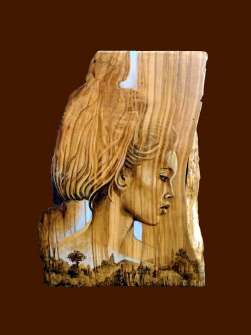
Bois d'olivier
35202018844_7b6de71649_b
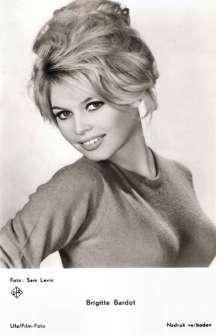
Brigitte Bardot
Dutch postcard by Gebr. Spanjersberg N.V., Rotterdam, no. 1201: Photo: Sam Lévin / Ufa..Beautiful French actress Brigitte Bardot (1934) was the sex kitten of the European film industry. BB starred in 48 films, performed in numerous musical shows, and recorded 80 songs. After her retirement in 1973, she established herself as an animal rights activist and made vegetarianism sexy.For more postcards, a bio and clips check out our blog European Film Star Postcards
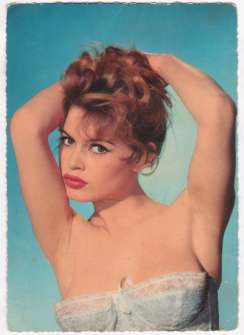
Brigitte Bardot
Scanned by me. Photo: Sam Levin / UFA. Krüger. 902/136.
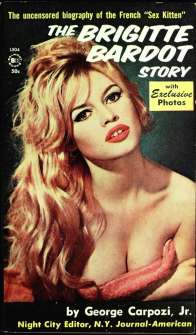
Belmont L-504 Paperback Original (1961). Photo of Brigitte Bardot on the cover
"She is a startling animal" -- Life Magazine.Here is the first complete story of Brigitte Bardot -- with 45 unforgettable photos and an intimate commentary in her own words -- today's most talked-about woman."A sizzling biography" -- Dorothy Kilgallen
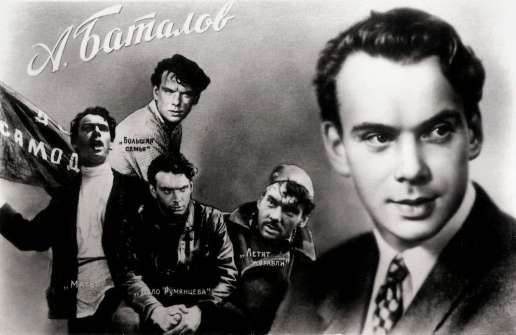
Aleksey Batalov (1928-2017)
Czechoslovakian postcard by Sluzba, Zilina. Pictures from Bolshaya Semya/The Big Family (Iosif Kheifets, 1954), Mat/Mother (Mark Donskoy, 1956), Delo Rumyantseva/The Case of Sergei Rumyantsev (Iosif Kheifits, 1956), and Letyat zhuravli/The Cranes Are Flying (Mikhail Kalatozov, 1957).On Thursday 15 June 2017, Russian actor and director Aleksey Batalov passed away in his hometown Moscow. He played positive and noble characters in several classics of the Soviet cinema such as Bolshaya Semya/The Big Family (Iosif Kheifets, 1954), Letyat zhuravli/The Cranes Are Flying (Mikhail Kalatozov, 1957), Dama s sobachkoi/The Lady with the Dog (Iosif Kheifits, 1962), and Oscar winner Moskva slezam ne verit/Moscow Does Not Believe in Tears (Vladimir Menshov, 1979). He was named a People's Artist of the USSR in 1976 and a Hero of Socialist Labour in 1989.Aleksei Vladimirovich Batalov was born in 1928, into a family associated with the theatre. He was born in the city of Vladimir, near Moscow, where his grandmother was the Doctor General at the Vladimir city hospital. His father, Vladimir Petrovich Batalov and his mother, Nina Antonovna Olshevskaya, were both actors of the Moscow Art Theatre (MKhAT) under the directorship of Konstantin Stanislavski and Vladimir Nemirovich-Danchenko. His uncle, Nikolai Batalov, was a distinguished film actor, who had starred in Vsevolod Pudovkin's classic Mother (1926). The Batalov family lived in the actor's apartments building at the Moscow Art Theatre. He then moved with his mother to the home of her second husband writer Viktor Ardov, who was the neighbour of Osip Mandelstam. Young Batalov became a good friend of Modernist poet Anna Akhmatova who stayed in his room during her many visits to Moscow. Later, in the 1960s, Aleksei Batalov painted an oil portrait of Anna Akhmatova. Writers Mikhail A. Bulgakov, Mikhail Zoschenko, Boris Pasternak were among the closest friends of the Batalov family, being also the colleagues of his stepfather Viktor Ardov. In 1944, upon his return from evacuation in Tatarstan, Aleksei Batalov made his film debut with a bit part in Zoya (Lev Arnshtam, 1944). He studied acting at the Moscow Art Theatre's Acting Studio-School of Vladimir Nemirovich-Danchenko and graduated in 1950. That same year he was drafted in the Red Army and worked as an actor with the Central Theatre of the Soviet Army from 1950-1953. Batalov joined the Moscow Art Theatre in 1953 but left three years later to concentrate on his career in film.Alexey Batalov hadshot to fame with his role in Bolshaya Semya/The Big Family (Iosif Kheifets, 1954). For that role he won the Best Actor award at the Cannes Film Festival, which he shared with his partners Sergei Lukyanov, Boris Andreyev, Nikolai Gritsenko, Pavel Kadochnikov, and others; the whole ensemble of actors and actresses were awarded for that film at Cannes, in 1955. Batalov received more international acclaim for his memorable acting opposite Tatyana Samoylova in Letyat zhuravli/The Cranes Are Flying (1957) for which director Mikhail Kalatozov won the Golden Palm at Cannes, in 1958. Batalov won the Jussi Diploma of Merit for the supporting role in Dama s sobachkoi/The Lady with the Dog (Iosif Kheifits, 1962), based on a story by Anton Chekhov. Batalov also worked with Kheifits in V gorode S./In the Town of S. (Iosif Kheifits, 1967), based on another story by Anton Chekhov. Batalov himself directed three films: Shinel/The Overcoat (1960) based on the story by Nikolai Gogol, Tri tolstyaka/Three Fat Men (co-directed with Iosif Shapiro, 1966) and Igrok/The Gambler (1973), an adaptation of the eponymous book by Fyodor Dostoevsky.Aleksey Batalov earned the State Prize of the USSR for a strong and difficult leading role opposite Innokentiy Smoktunovskiy in 9 dney odnogo goda/Nine Days in One Year (1961), for which director Mikhail Romm won the Crystal Globe. Batalov's performance in the leading role of a Russian intellectual in Beg/The Flight (Aleksandr Alov, Vladimir Naumov, 1970) based on the play by Mikhail A. Bulgakov, was somewhat overshadowed by the brilliant duo of his film partners Mikhail Ulyanov and Evgeniy Evstigneev. In the 1970s he concentrated on his professorship at the Gerasimov Institute of Cinematography. Batalov made a successful comeback in Moskva slezam ne verit/Moscow Does Not Believe in Tears (Vladimir Menshov, 1979), which won an Oscar for the Best Foreign Language Film (1981). After that, he effectively retired from acting and devoted his time to coaching new generations of film actors. In addition to his numerous international awards Batalov was honoured with the title of the People's Artist of the USSR (1976). He was decorated and received many Soviet and Russian awards from the state. Batalov was the Dean of the Actors Studio at the Moscow State Film Institute (VGIK) from 1975 to 2005. He taught over 20 acting seminars in the USA and Canada. He also made notable works for the Moscow Radio. Batalov died on 14 June 2017 in Moscow from complications of a fall, which resulted in a broken neck and hip, at the age of 88. He was married to Gitana Leontyenko and they had one child.Sources: Steve Shelokhonov (IMDb), Wikipedia and IMDb.
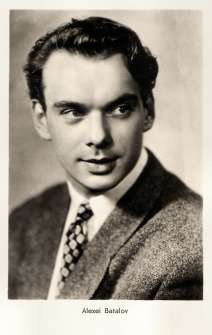
Aleksey Batalov (1928-2017)
Czechoslovakian postcard.On Thursday 15 June 2017, Russian actor and director Aleksey Batalov passed away in his hometown Moscow. He played positive and noble characters in several classics of the Soviet cinema such as Bolshaya Semya/The Big Family (Iosif Kheifets, 1954), Letyat zhuravli/The Cranes Are Flying (Mikhail Kalatozov, 1957), Dama s sobachkoi/The Lady with the Dog (Iosif Kheifits, 1962), and Oscar winner Moskva slezam ne verit/Moscow Does Not Believe in Tears (Vladimir Menshov, 1979). He was named a People's Artist of the USSR in 1976 and a Hero of Socialist Labour in 1989.Aleksei Vladimirovich Batalov was born in 1928, into a family associated with the theatre. He was born in the city of Vladimir, near Moscow, where his grandmother was the Doctor General at the Vladimir city hospital. His father, Vladimir Petrovich Batalov and his mother, Nina Antonovna Olshevskaya, were both actors of the Moscow Art Theatre (MKhAT) under the directorship of Konstantin Stanislavski and Vladimir Nemirovich-Danchenko. His uncle, Nikolai Batalov, was a distinguished film actor, who had starred in Vsevolod Pudovkin's classic Mother (1926). The Batalov family lived in the actor's apartments building at the Moscow Art Theatre. He then moved with his mother to the home of her second husband writer Viktor Ardov, who was the neighbour of Osip Mandelstam. Young Batalov became a good friend of Modernist poet Anna Akhmatova who stayed in his room during her many visits to Moscow. Later, in the 1960s, Aleksei Batalov painted an oil portrait of Anna Akhmatova. Writers Mikhail A. Bulgakov, Mikhail Zoschenko, Boris Pasternak were among the closest friends of the Batalov family, being also the colleagues of his stepfather Viktor Ardov. In 1944, upon his return from evacuation in Tatarstan, Aleksei Batalov made his film debut with a bit part in Zoya (Lev Arnshtam, 1944). He studied acting at the Moscow Art Theatre's Acting Studio-School of Vladimir Nemirovich-Danchenko and graduated in 1950. That same year he was drafted in the Red Army and worked as an actor with the Central Theatre of the Soviet Army from 1950-1953. Batalov joined the Moscow Art Theatre in 1953 but left three years later to concentrate on his career in film.Alexey Batalov hadshot to fame with his role in Bolshaya Semya/The Big Family (Iosif Kheifets, 1954). For that role he won the Best Actor award at the Cannes Film Festival, which he shared with his partners Sergei Lukyanov, Boris Andreyev, Nikolai Gritsenko, Pavel Kadochnikov, and others; the whole ensemble of actors and actresses were awarded for that film at Cannes, in 1955. Batalov received more international acclaim for his memorable acting opposite Tatyana Samoylova in Letyat zhuravli/The Cranes Are Flying (1957) for which director Mikhail Kalatozov won the Golden Palm at Cannes, in 1958. Batalov won the Jussi Diploma of Merit for the supporting role in Dama s sobachkoi/The Lady with the Dog (Iosif Kheifits, 1962), based on a story by Anton Chekhov. Batalov also worked with Kheifits in V gorode S./In the Town of S. (Iosif Kheifits, 1967), based on another story by Anton Chekhov. Batalov himself directed three films: Shinel/The Overcoat (1960) based on the story by Nikolai Gogol, Tri tolstyaka/Three Fat Men (co-directed with Iosif Shapiro, 1966) and Igrok/The Gambler (1973), an adaptation of the eponymous book by Fyodor Dostoevsky.Aleksey Batalov earned the State Prize of the USSR for a strong and difficult leading role opposite Innokentiy Smoktunovskiy in 9 dney odnogo goda/Nine Days in One Year (1961), for which director Mikhail Romm won the Crystal Globe. Batalov's performance in the leading role of a Russian intellectual in Beg/The Flight (Aleksandr Alov, Vladimir Naumov, 1970) based on the play by Mikhail A. Bulgakov, was somewhat overshadowed by the brilliant duo of his film partners Mikhail Ulyanov and Evgeniy Evstigneev. In the 1970s he concentrated on his professorship at the Gerasimov Institute of Cinematography. Batalov made a successful comeback in Moskva slezam ne verit/Moscow Does Not Believe in Tears (Vladimir Menshov, 1979), which won an Oscar for the Best Foreign Language Film (1981). After that, he effectively retired from acting and devoted his time to coaching new generations of film actors. In addition to his numerous international awards Batalov was honoured with the title of the People's Artist of the USSR (1976). He was decorated and received many Soviet and Russian awards from the state. Batalov was the Dean of the Actors Studio at the Moscow State Film Institute (VGIK) from 1975 to 2005. He taught over 20 acting seminars in the USA and Canada. He also made notable works for the Moscow Radio. Batalov died on 14 June 2017 in Moscow from complications of a fall, which resulted in a broken neck and hip, at the age of 88. He was married to Gitana Leontyenko and they had one child.Source: Steve Shelokhonov (IMDb), Wikipedia and IMDb.
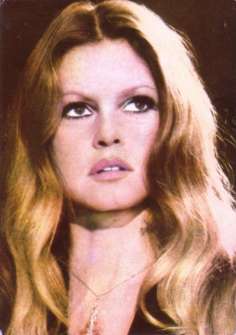
Brigitte Bardot
Scanned by me. Postcard by CASA FILMULUI ACIN. C.P.C.S.
C-da 43 139.










